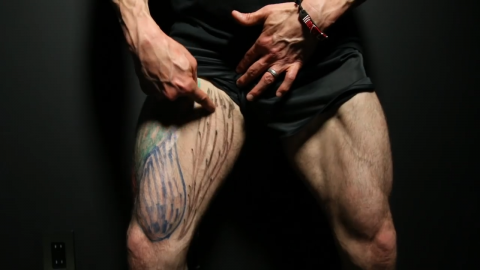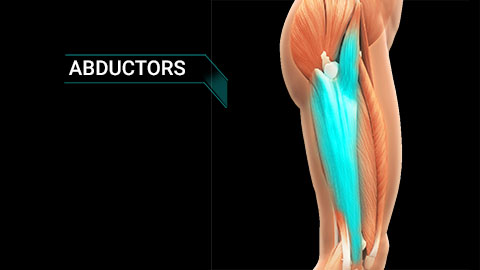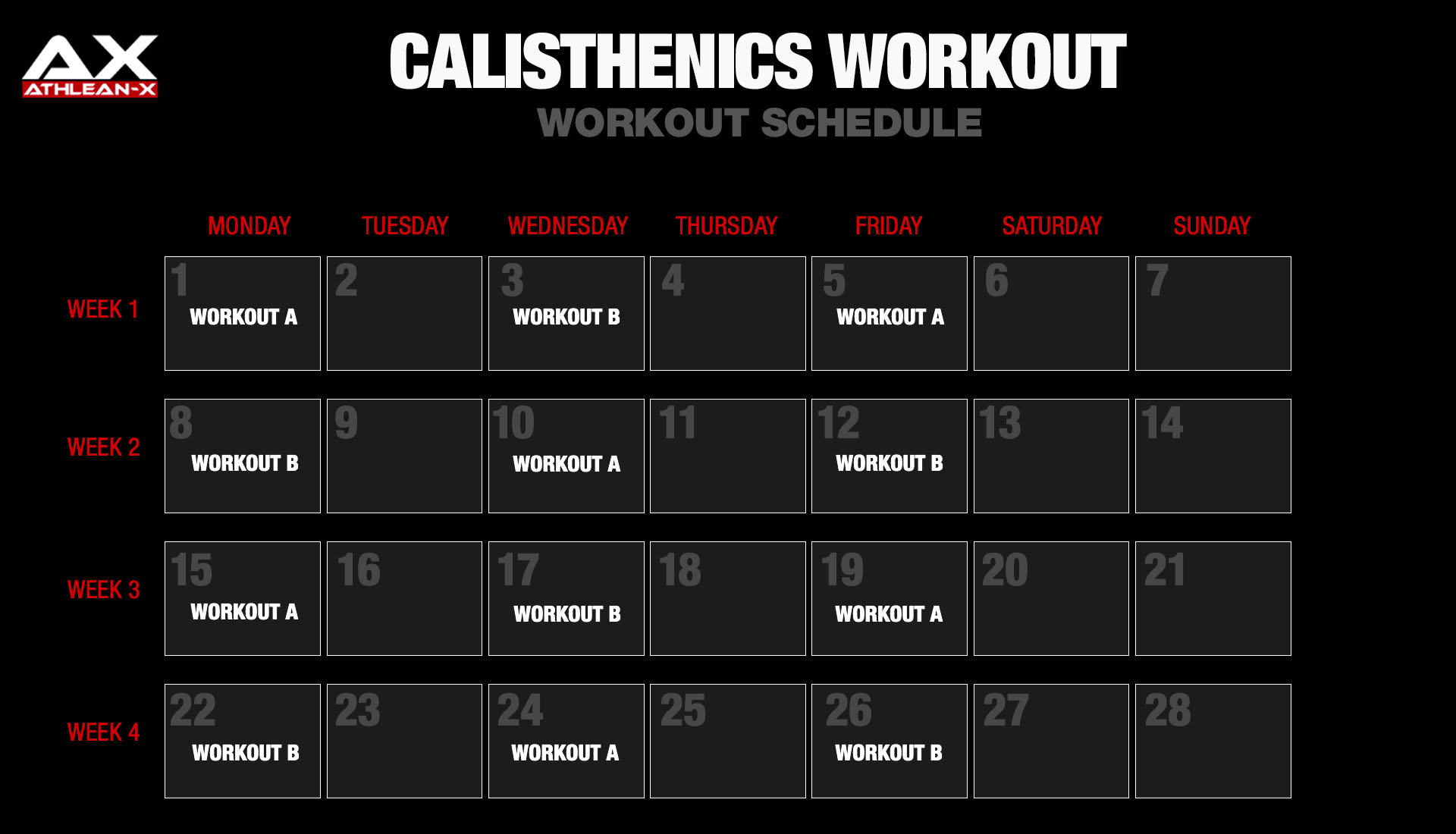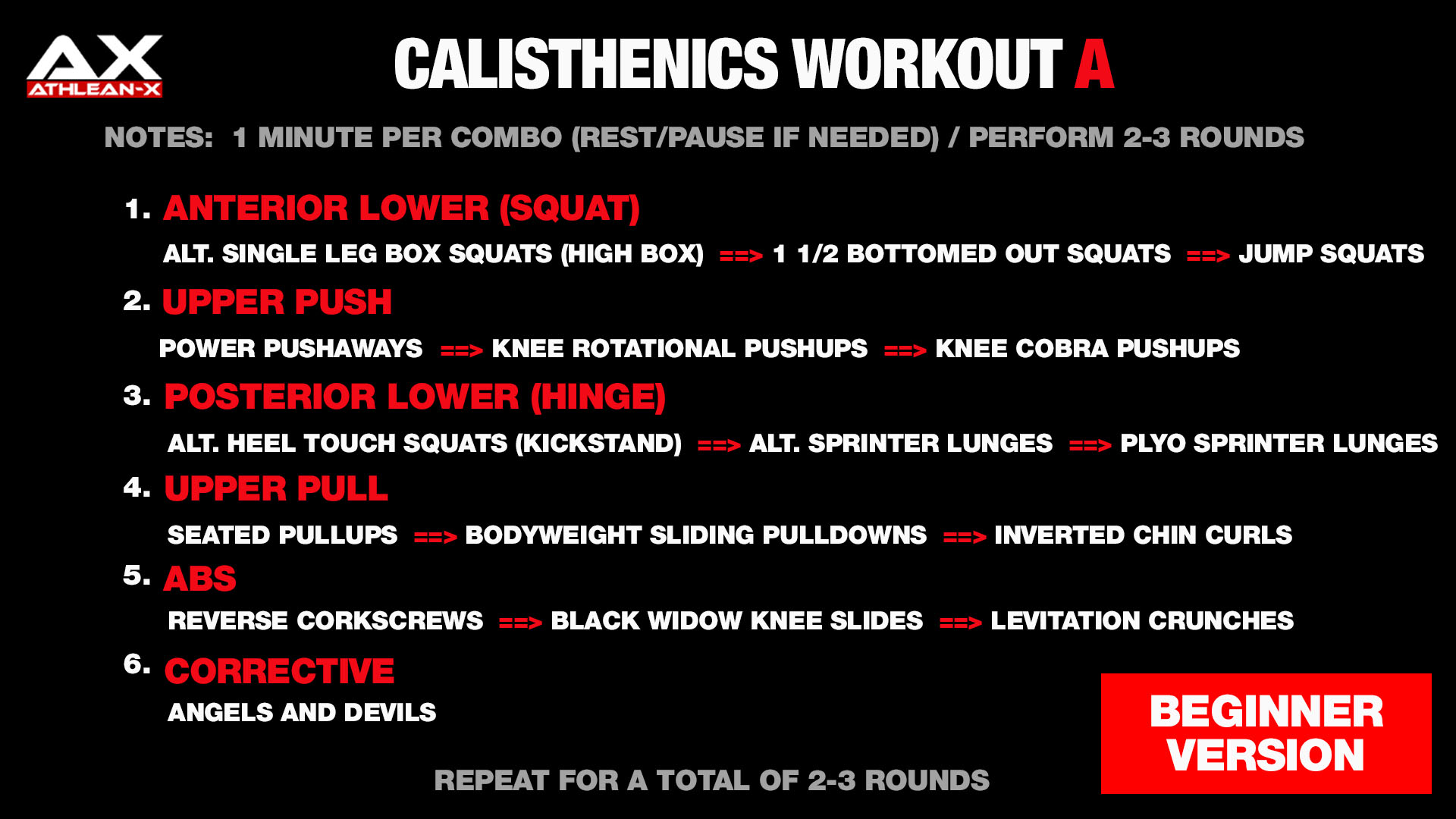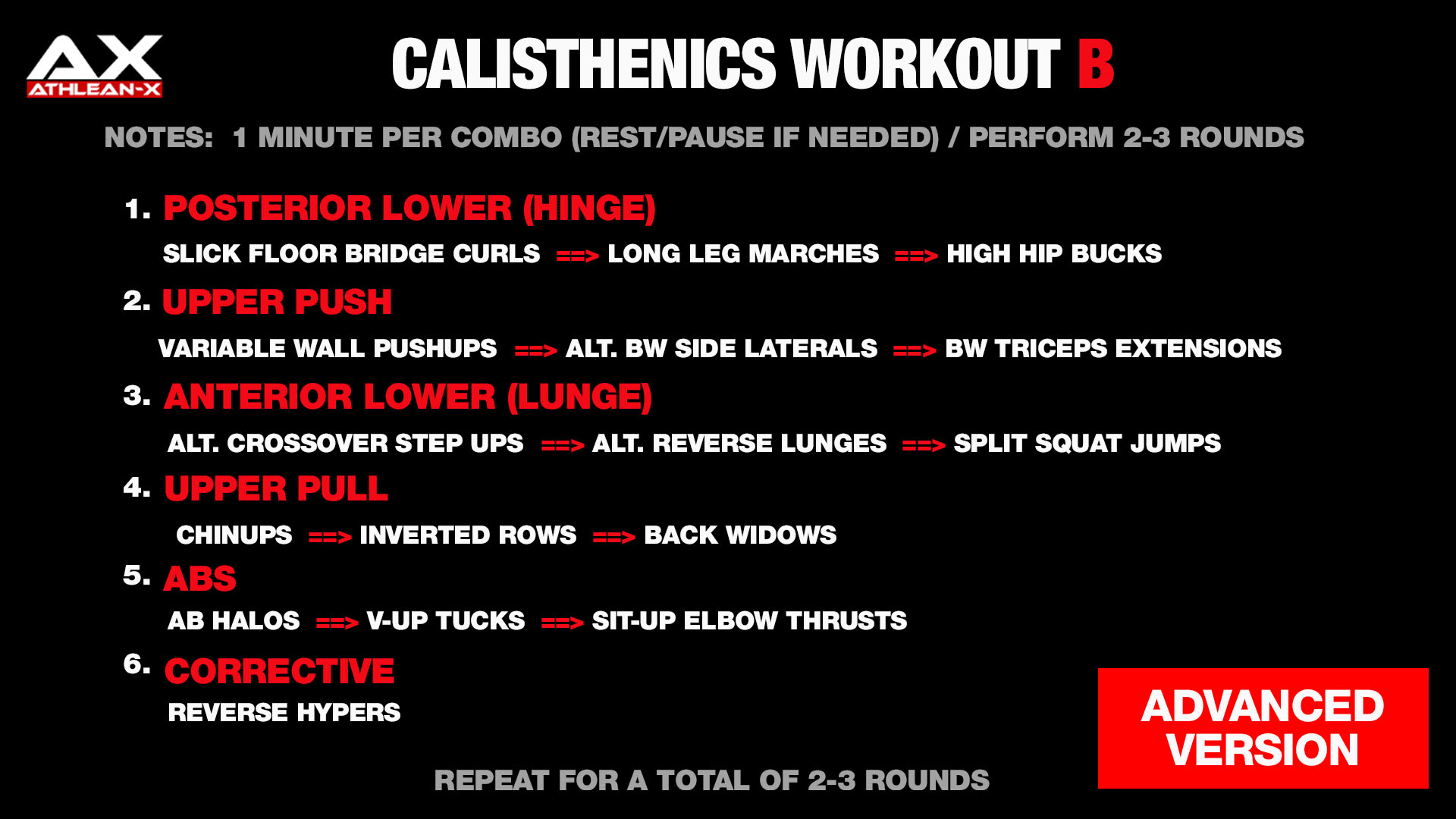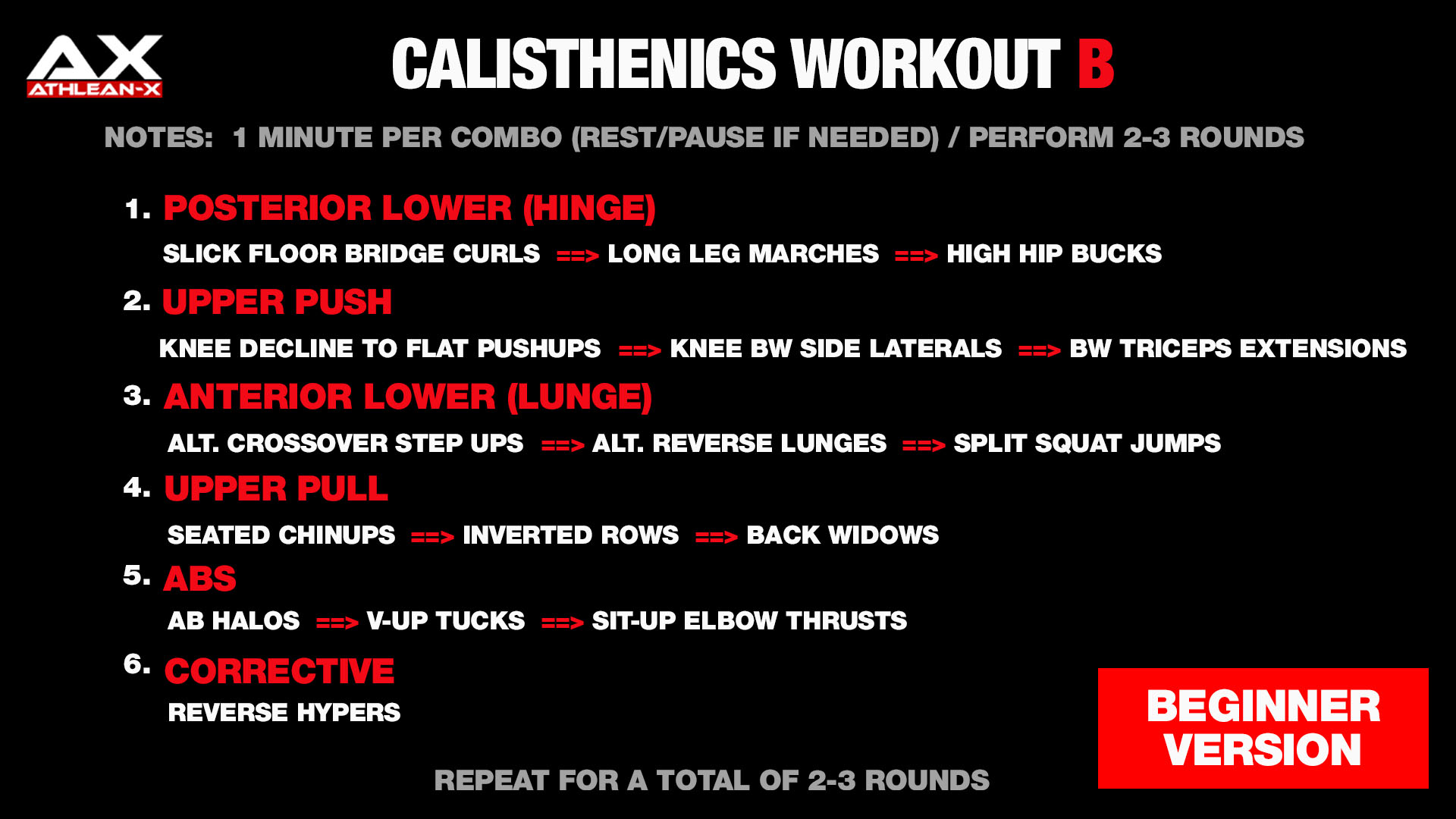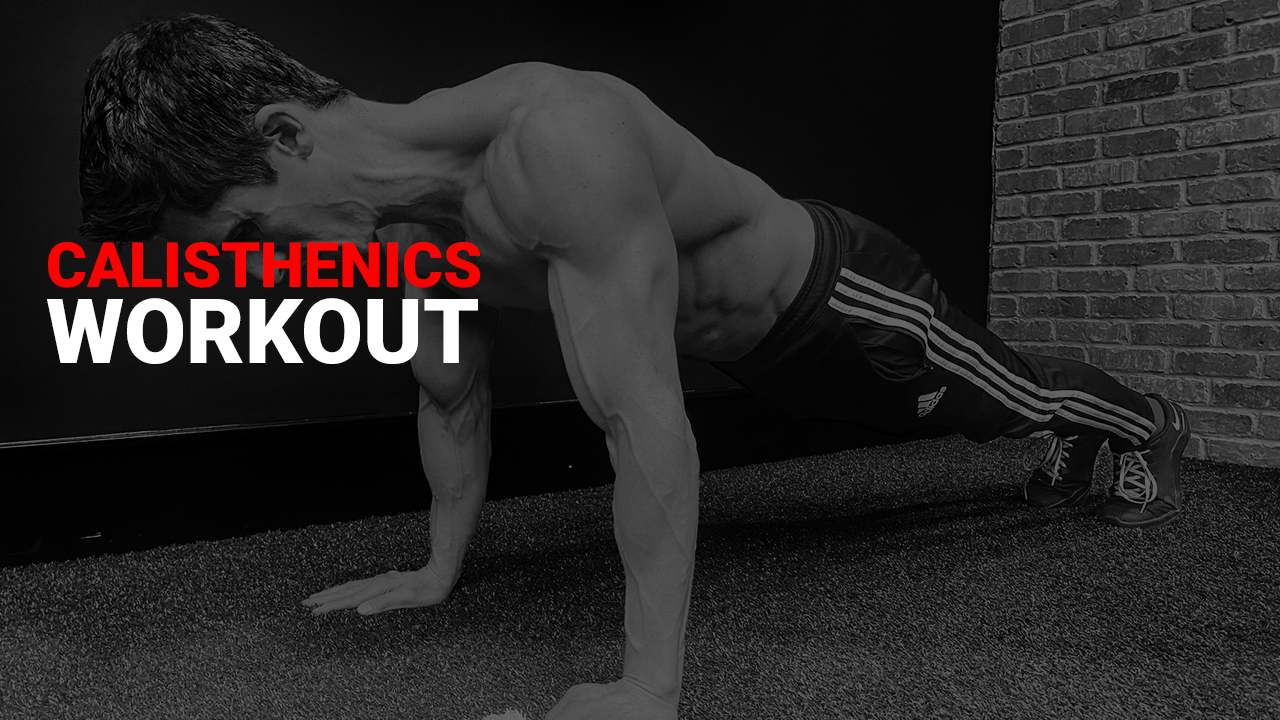
calisthenics workouts
It wasn’t that long ago that the word “calisthenics” was completely foreign to the popular workout scene.
Back then, it was all about iron and brawn. If you did calisthenic exercises, you were thought to probably be in a cardio class. But times are much different now.
Hop on over to YouTube and you’ll see a ton of videos demonstrating some incredible feats of strength through calisthenic exercises alone such as One-Arm Pull-Ups, One-Legged Squats, Handstand Push-Ups, and other advanced exercises.
Some of you might be wondering, “Jeff, what is a calisthenics workout?”
I’ve got you covered. Here’s a complete guide to calisthenics, including which exercises to do, how to do them, and a full calisthenics workout plan.
WHAT IS A CALISTHENIC WORKOUT?
Calisthenics refers to a form of exercise that uses purely bodyweight as resistance. Yes, on the surface you’re doing bodyweight exercises, but there’s more to it than that.
Unlike weight-based training exercises, where you have to get up to change or get extra weights or equipment, calisthenic exercises just require a simple change of angle to alter the intensity.
For example, let’s say you start with a Standard Push-Up, but you want to target your shoulders more. All you have to do is put your hips toward the ceiling and move into a Pike Push-Up position.
Put a bunch of these basic exercises together and what do you have? A calisthenics training routine.
Specifically, a calisthenics workout consists of a series of bodyweight exercises that are performed in sequence. These exercises can be customized to suit your fitness level and individual goals, such as building muscle or increasing strength.
To really drive the point home, here are some common examples of calisthenics exercises that you are probably familiar with:
- Jumping Jacks
- Lunge
- Pull-Ups
- Chin-Ups
- Pistol Squats
- Regular Push-Ups
BENEFITS OF CALISTHENICS
If you’ve been lifting weights during your fitness journey, you might be a bit skeptical about moving over to exercise progressions that only use body weight.
Here are some of the benefits of calisthenics training that’ll make you a believer.
TOTAL BODY STRENGTH
You don’t need weights to get strong. Calisthenics exercises are just as effective at building total body strength. The trick is that you have to consistently challenge yourself by changing up the angle, stability, or number of arms and legs you’re using.
CONVENIENCE AND FLEXIBILITY
Another major benefit of calisthenics is that they can be done anywhere, anytime. Whether you’re traveling or just don’t have time to get to the gym, these exercises are perfect for fitting in a quick workout whenever and wherever you want.
LOW IMPACT
If you’re someone who is recovering from an injury or dealing with joint pain, calisthenics can be a great way to keep your fitness journey on track without putting additional stress on your body. Because these exercises use your own weight as resistance, they are gentle on the joints and easy for most people to do.
IMPROVED COORDINATION
Performing complex movements like Squats or Burpees requires coordination between multiple muscle groups. Doing these exercises regularly can help you better coordinate your movements and improve your overall fitness performance.
ENHANCED MOBILITY
Many calisthenics exercises, such as Push-Ups and Squats, require a full range of motion in order to be performed correctly. This can help increase your overall flexibility and mobility, which is especially important as you get older.
TIME-EFFICIENT
Calisthenics workouts can be done anywhere, which means you don’t have to spend hours at the gym. In fact, you can get in a great workout in just 20-to-30 minutes!
5 TYPES OF CALISTHENICS
You’re convinced that calisthenics can become an important part of your workout routine, but you’re not sure where to start.
What type of calisthenic exercises should you focus on?
It’s important to look at a calisthenics workout plan as a total body workout.
In other words, how can you arrange your workout in a way that hits everything and not just individual muscles with specific exercises for each like a traditional bodybuilding plan?
The way to arrange your workouts is by focusing on hitting the five major functions for muscle groups:
- Lower Body Anterior Chain
- Upper Body Upper Push
- Lower Body Posterior Chain
- Upper Body Pull
- Abdominal Circuit
LOWER BODY ANTERIOR CHAIN
When building a calisthenics workout, I’d recommend starting with the lower body and an anterior chain focus. In other words, start with the compound exercises that demand the most from the front of your lower body.
In this case, you’ll primarily be focusing on the quadriceps, which has four sections of muscle fibers:
VASTUS MEDIALIS


The Vastus Medialis is in the center of the quad, slightly on the inside of the knee. It helps with the extension of the knee.
VASTUS INTERMEDIUS

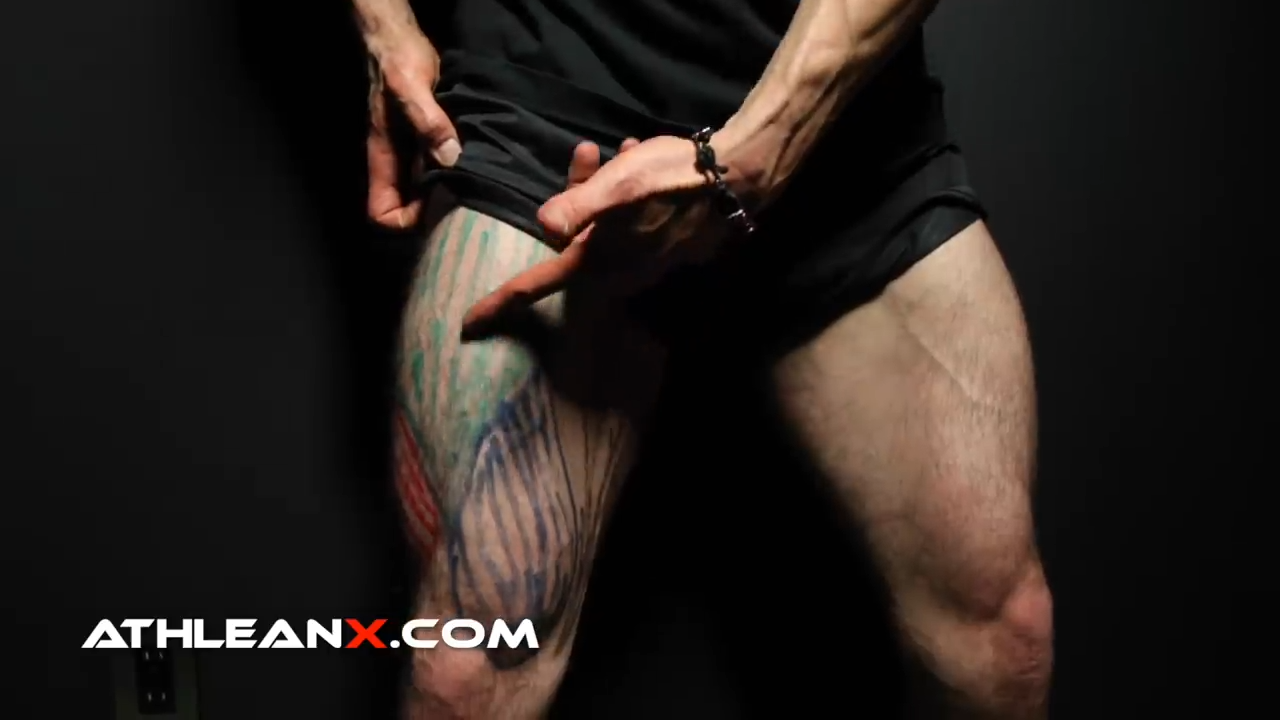
The Vastus Intermedius is also near the center of the quad, but it is beneath the muscle in the middle of the knee. Therefore, it can’t be directly seen like the other parts. It is also involved in knee extension.
VASTUS LATERALIS

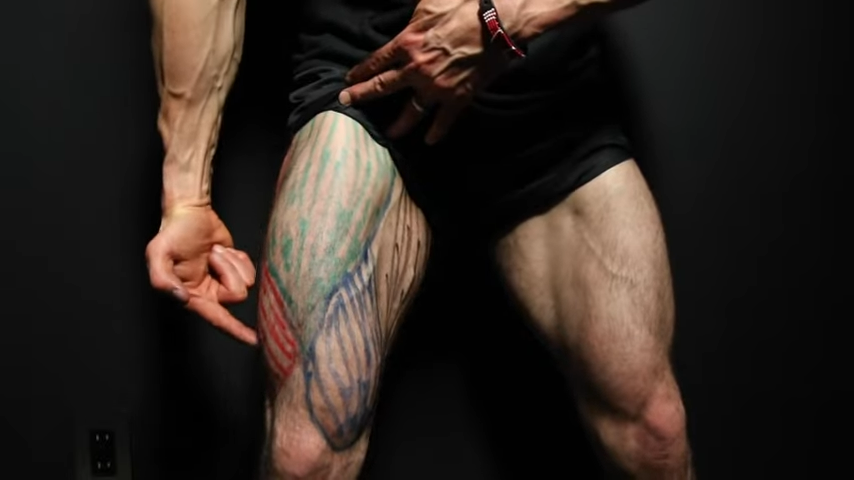
The Vastus Lateralis is on the outside of the knee, and it also assists with knee extension.
RECTUS FEMORIS


The Rectus Femoris is on the upper part of the quad. It’s the only section of the quads that has an attachment above the hip, which means it can assist with flexion.
UPPER BODY UPPER PUSH
Next up, you should plan out the exercises you’ll be doing that target the upper body, specifically the muscles that are responsible for “pushing” actions.
UPPER CHEST


The upper chest muscle fibers can be activated during exercises like the Handstand Push-Up or the Parallel Incline Push-Up.
MIDDLE CHEST


The standard push-up will target the middle chest muscle fibers.
LOWER CHEST


Your traditional Decline Push-Ups are a great go-to exercise for this part of the pecs.
SHOULDER: FRONT DELT


The first shoulder muscles that we’re reviewing are the front deltoids. Regular Push-Ups hit the front delts.
SHOULDERS: MIDDLE DELT

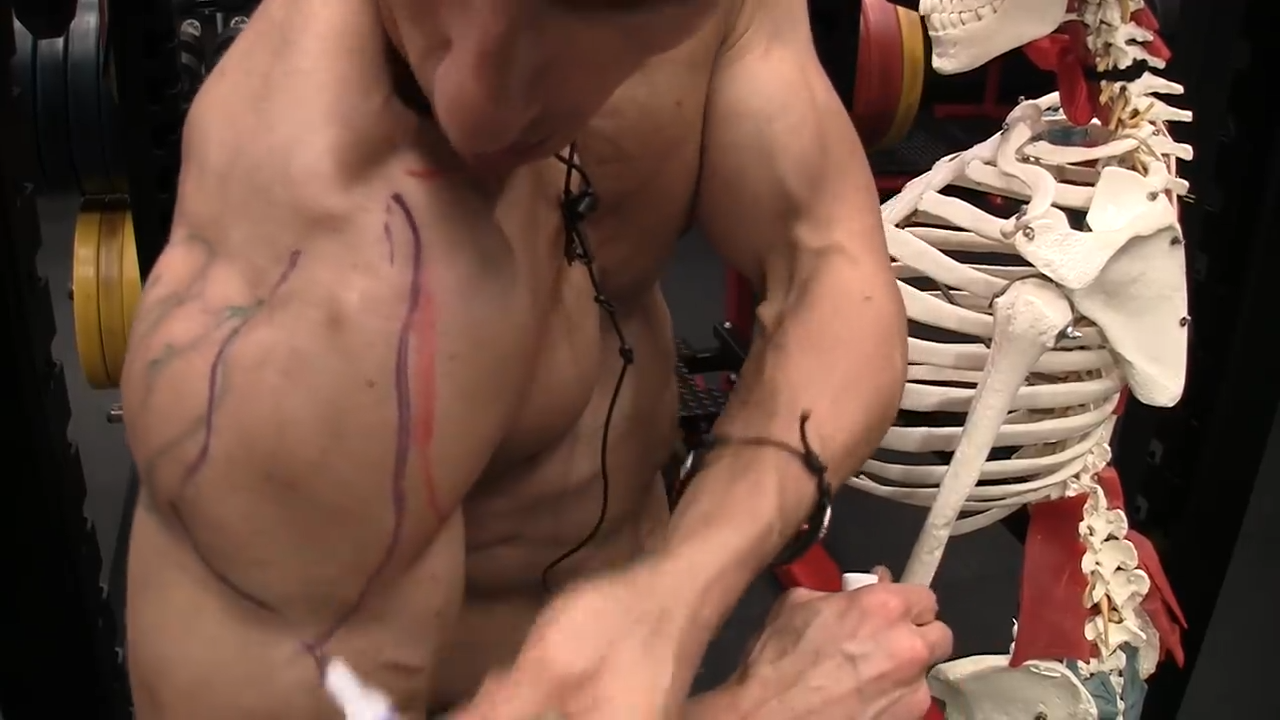
Lateral Raises and the Seated Arnold Press will take care of the middle deltoid muscle.
TRICEPS: LATERAL HEAD


On the back of the arm is where you’re find the lateral head of the triceps. Since triceps are activated by pushing movements, you can target it from the Push-Up position. From here, you can do regular Push-Ups, Decline Push-Ups, or Diamond Push-Ups to activate the triceps more than the pecs.
TRICEPS: MEDIAL HEAD

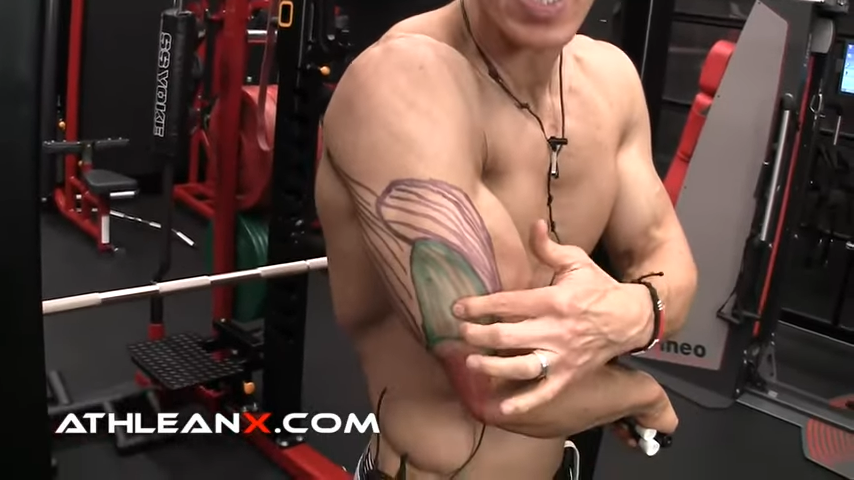
Right next to the lateral head of the triceps, you’ll find the medial head. The best bodyweight exercises for this are going to be Push-Ups, especially with a narrow stance.
TRICEPS: LONG HEAD


Triceps Extensions and Close-Grip Bench Presses are excellent for the long head of the triceps, but if you only have bodyweight, you can do Towel Triceps Extensions and Narrow Push-Ups.
LOWER BODY POSTERIOR CHAIN
From the upper body, we’ll head back to the lower body. This time, we’ll focus on the muscle groups on the back of your body.
Once we get into these calisthenic exercises below, you’ll notice that we will make some slight changes to the positioning to shift the focus away from quad dominance and more toward glute dominance.
On the back side of the leg muscles, the hamstrings have two main muscle groups we want to make sure we’re focusing on:
BICEPS FEMORIS


The Biceps Femoris is on the outside of the hamstring. Basic movements like the Romanian Deadlift are great for this muscle group. They can also be targeted with advanced calisthenics exercises like the Single-Leg Deadlift.
SEMITENDINOSUS

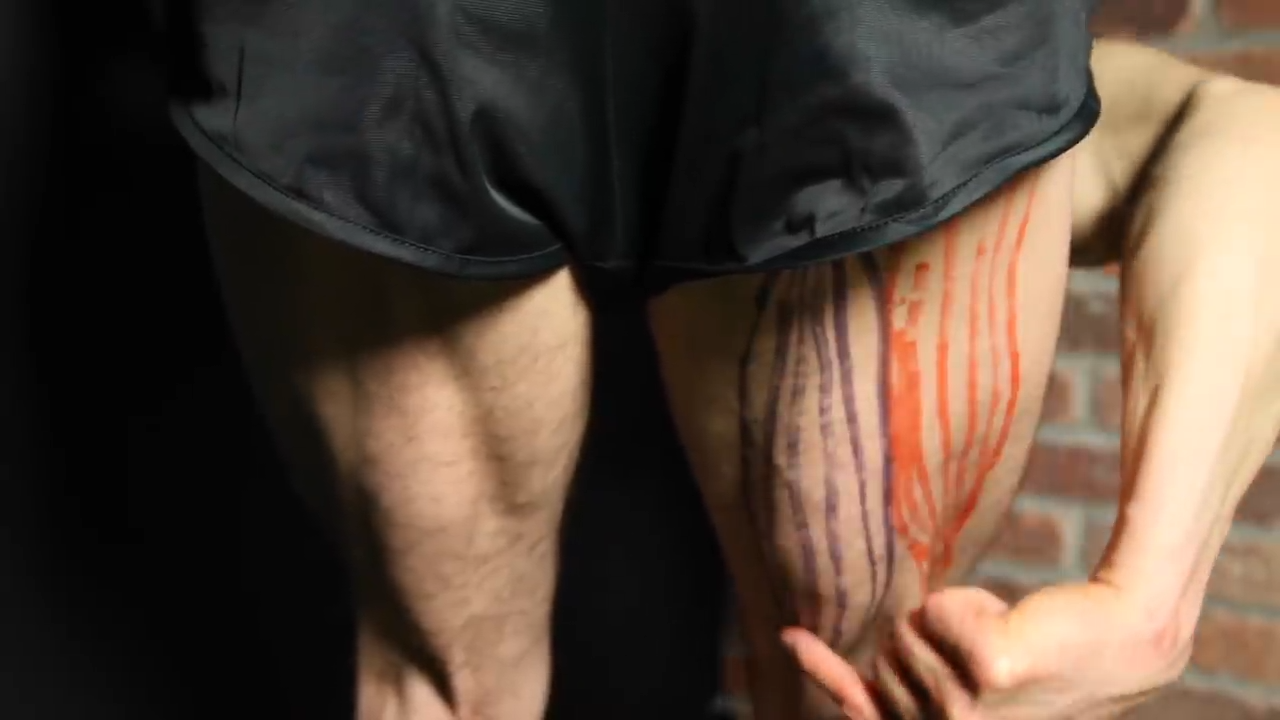
Just like the adductor muscles, the abductors are a muscle group that is usually forgotten. It’s important that you incorporate exercises that target both.
UPPER BODY UPPER PULL
We covered the front of the upper body and now it’s time to review the other side. The muscles on the back of your body tend to be involved in “pulling” exercises. For example, Pull-Ups and Assisted Pull-Ups are common calisthenics exercises for this section.
THE LATS

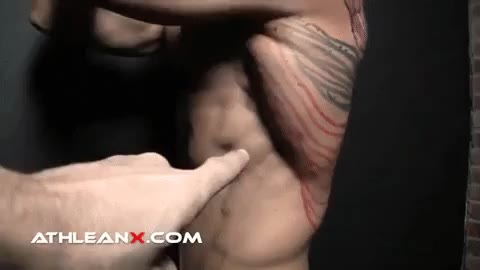
One of the largest muscles on the back, the latissimus dorsi can be activated with simple pull-up bars. The most popular bodyweight exercise to target the lats is the Pull-Up.
UPPER AND LOWER TRAPS

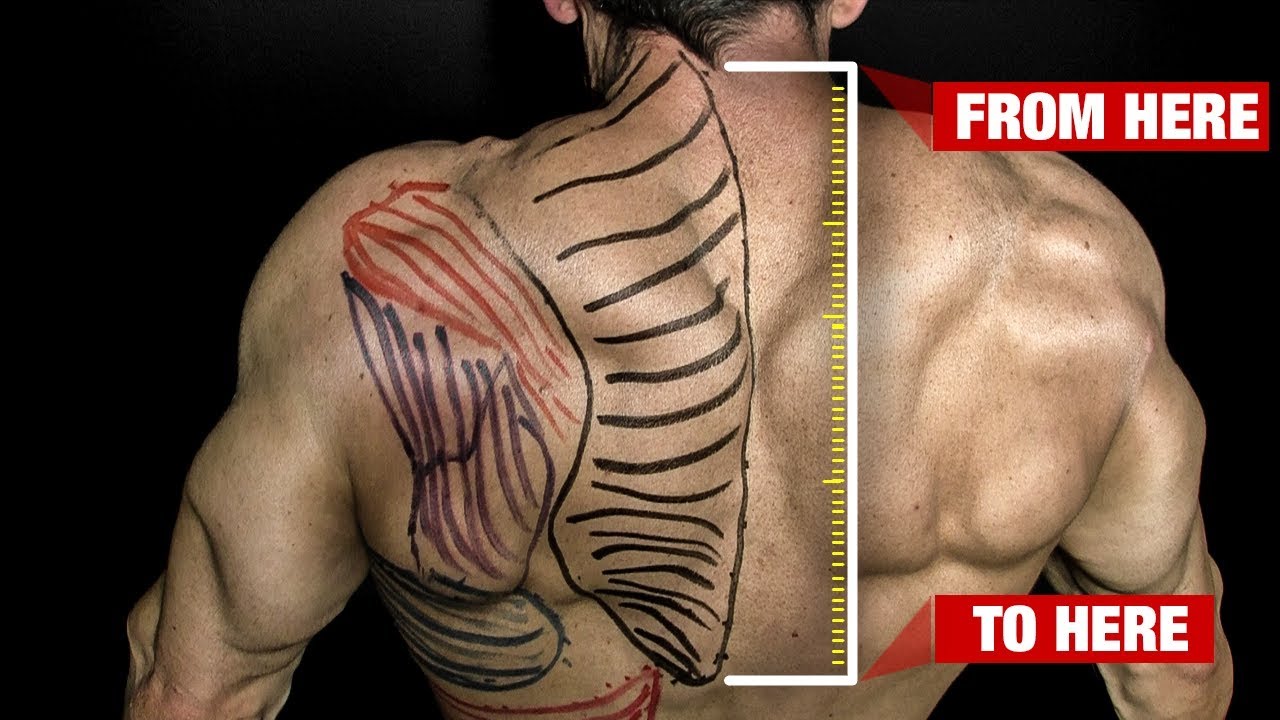
North of the lats, and another large muscle group on the back, you’ll find the upper and lower traps. Shrugs are the classic traps exercise.
REAR DELTS

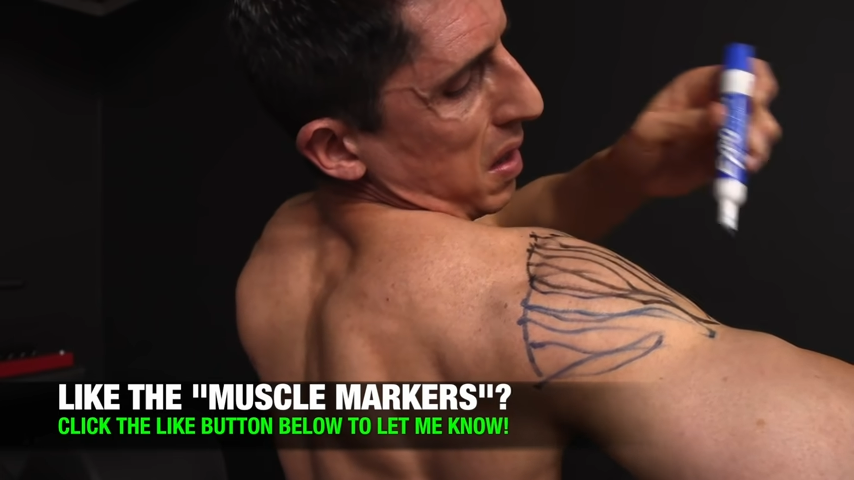
Now we get to the posterior shoulders. The rear delts are very important for all back exercises because they are directly involved, helping with stability.
LOW BACK / ERECTOR SPINAE


Speaking of stability, the erector spinae and the lower back are stabilizer muscles that are important for maintaining posture during your calisthenics workout.
ROTATOR CUFF


Another important muscle that helps with stability, especially for the arm bone, the rotator cuff is a muscle you don’t want to neglect.
TERES MAJOR


You might be surprised to learn that the Dumbbell Pullover is a great way to hit the teres major.
SHORT HEAD (INNER BICEPS)

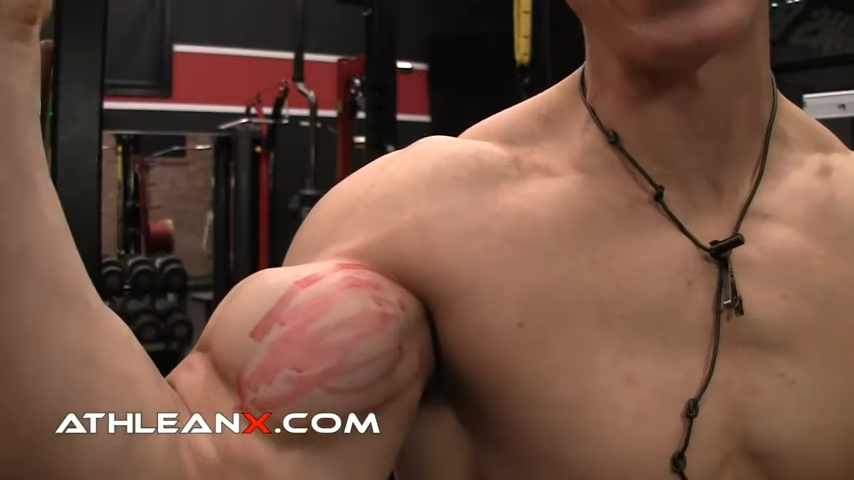
Ordinarily, if you’re going after the biceps, I’d say you should choose Dumbbell Curls and Barbell Curls. But this is all about calisthenics, so in this case, I’ll direct you to Chin-Ups.
LONG HEAD (OUTER BICEPS)

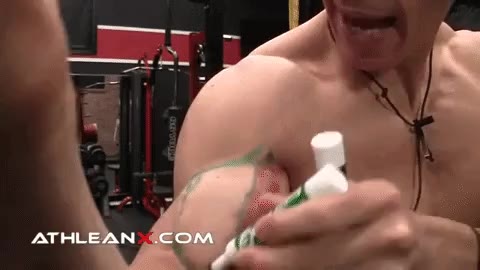
Wide Grip Chin-Ups are a great way to target the long head of the biceps.
BRACHIALIS


A muscle that doesn’t get nearly the attention it deserves, and yet, it’s essential if you want thicker arms.
CORE CIRCUIT
Finally, we get to arguably the most important group of muscles: your core musculature. From basic movements to advanced movements, they all originate from the core.
Naturally, it’s essential to target each part of your core. Let’s start with the core muscles that everyone knows: the rectus abdominis.
RECTUS ABDOMINIS


This rectus abdominis is better known as the “six-pack muscle.” Aside from looking good, it’s also important for overall core strength.
The abs go up and down, north and south, attaching at the ribcage down to the pelvis. That means that it’s driving the movement of flexion of our torso, top down or bottom up.
EXTERNAL AND INTERNAL OBLIQUES

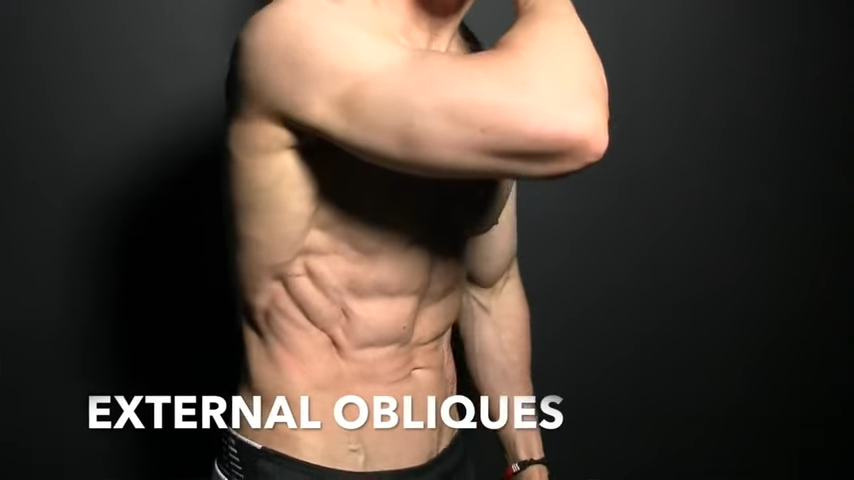
The direction of the fibers determines the function, so the external obliques are going to be good at helping you to rotate and control rotation.

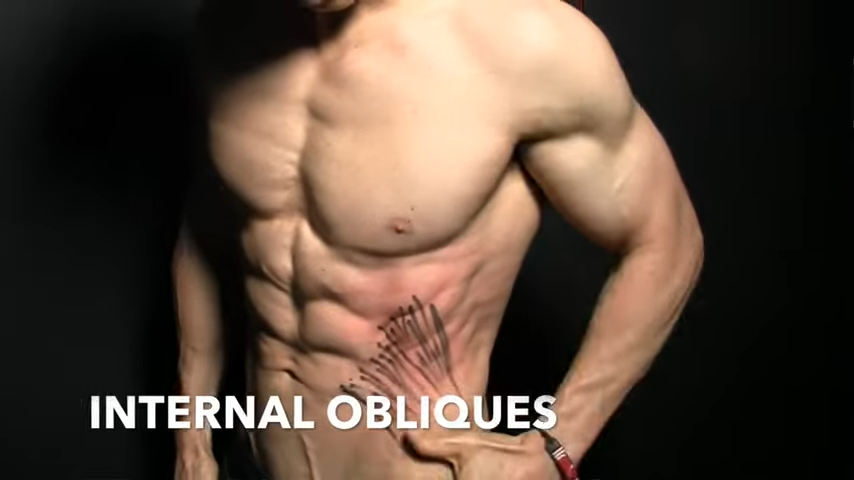
Ironically, the internal obliques run at the opposite direction from the external obliques. The obliques on one side of the body work in sync with the obliques on the opposite side to ensure rotation is possible during all those twisting exercises.
TRANSVERSE ABDOMINIS


The transverse abdominis runs like a weight belt around your waist, and it helps to drive stability.
SERRATUS ANTERIOR

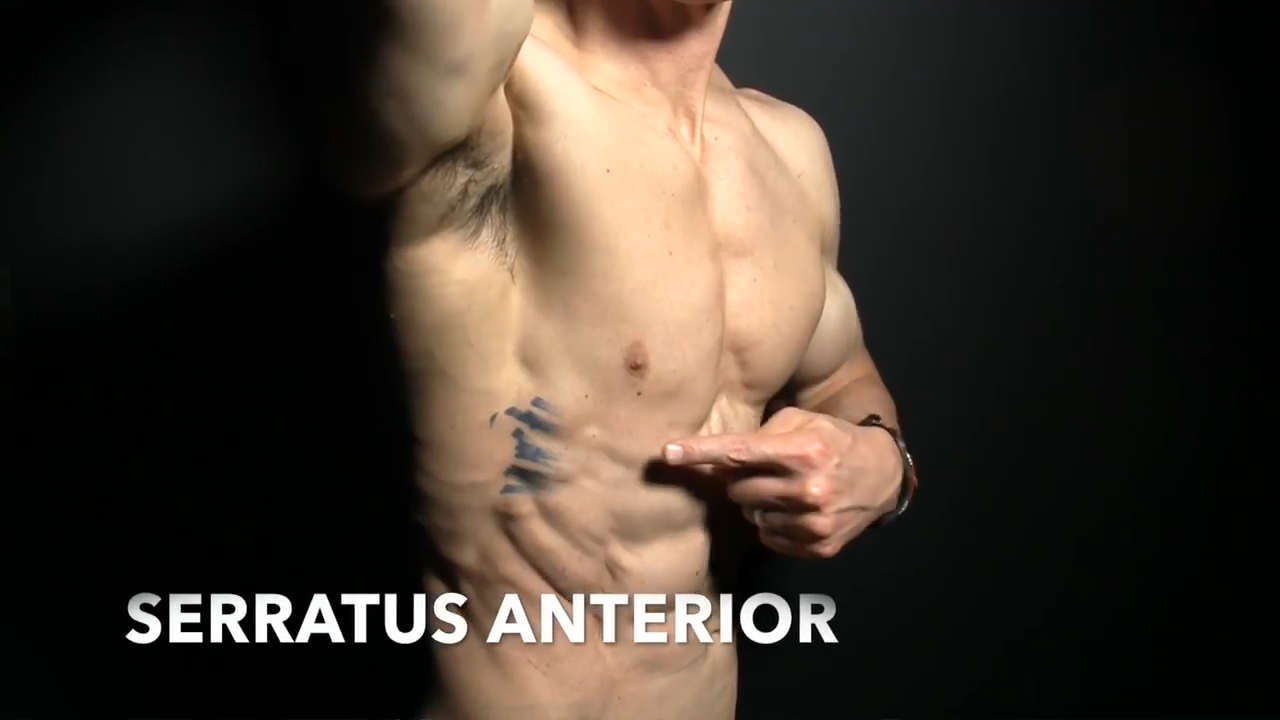
The serratus anterior has an important function in stabilizing the trunk by keeping the shoulder blades in contact with the rib cage.
CAN YOU BUILD MUSCLE WITH JUST CALISTHENICS?
Yes! In fact, many people who use calisthenics workouts do so specifically because they want to build muscle without lifting weights.
Naturally, this makes bodyweight workouts ideal for beginners, people who want to maintain what they’ve built so far, and people who want to focus on reconditioning.
The real beauty of calisthenics exercises lies in the fact that the progressions and regressions of the movements are up to you. You can easily make them as beginner friendly or as challenging as you want.
With that said, calisthenics exercises (as I’m going to show you) are just as effective for people who have been lifting for years and want to tap into more or different forms of muscle growth.
Sure, you might need to use some advanced exercise variations, but you’d be surprised at the muscles you use during a Pull-Up compared to a Bent-Over Barbell Row.
Speaking of external weights, just because you’re not holding a dumbbell or barbell doesn’t mean that you’re not engaging in an effective form of resistance training.
Calisthenics IS resistance training. The only difference is that your body is providing that resistance.
When done correctly, calisthenics can be an effective way to build muscle and strength. The key is to choose the right exercises for your goals, learn how to perform those exercises so that muscle mass is the end goal, and be consistent with your calisthenics workout routines.
Naturally as you get stronger, you want to continue to challenge yourself by trying difficult progressions. The stronger you become, the more you should consistently and appropriately increase some form of variables such as intensity, duration, or frequency.
11 BEST CALISTHENICS EXERCISES
I’d say the hallmark of fundamental exercises is that they can be used in any type of fitness routine.
So, whether you’re doing basic calisthenics exercises or advanced isometric exercises, if you can incorporate an exercise or a variation of that exercise into the workout, you know it’s good.
With that said, I have a list of calisthenics exercises that will be able to find a home no matter what your fitness goal is or what is on your workout calendar.
What makes these calisthenic exercises great and not just another basic workout?
Aside from being perfect complements for resistance training workouts, these awesome body weight exercises are designed to hit 2-3 times as many muscles as your typical isolation workout.
They can also be regressed into beginner movements, allowing you to perfect the form and advance at your pace. Even if you only incorporate 2-3 exercises from this list into your program, I’m sure you’ll see a big difference in your results.
Best of all, you don’t need any expensive equipment – just your standard gym equipment of a pull-up bar.
Here are my top 11 picks for the best bodyweight movements. We’ll start with the big compound exercises for legs, back, and chest, then work our way around to the just as important support and stabilizer muscles and core muscles.
LEVITATION SQUAT

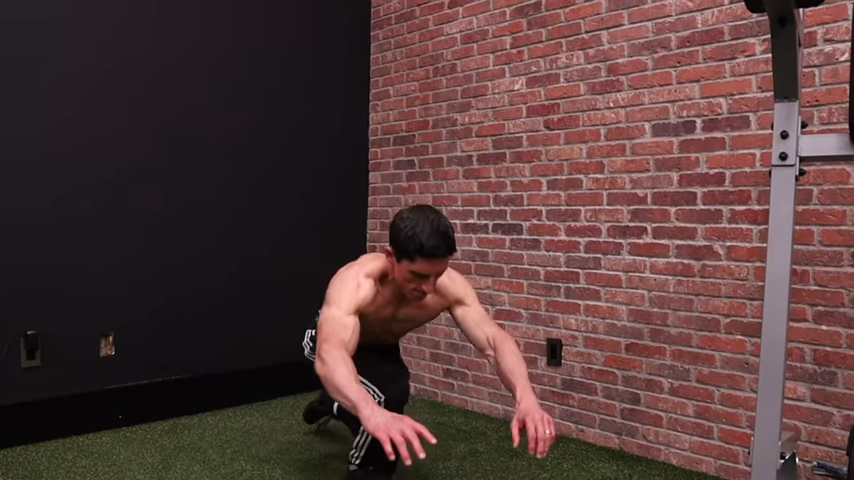
Out first calisthenics exercise focuses on your legs, and while this is an easier exercise for beginners to start with, it will not compromise the gains that experienced lifters have built.
Levitation Squats allow you to tap into the overload that is possible with single leg exercises, but without some of the negatives that might come along with Pistol Squats.
For example, there is much less knee flexion, which allows for people that have meniscal issues to perform the exercise pain free.
It’s the perfect exercise to complement the next exercise on my list.
GLUTE HAM RAISE

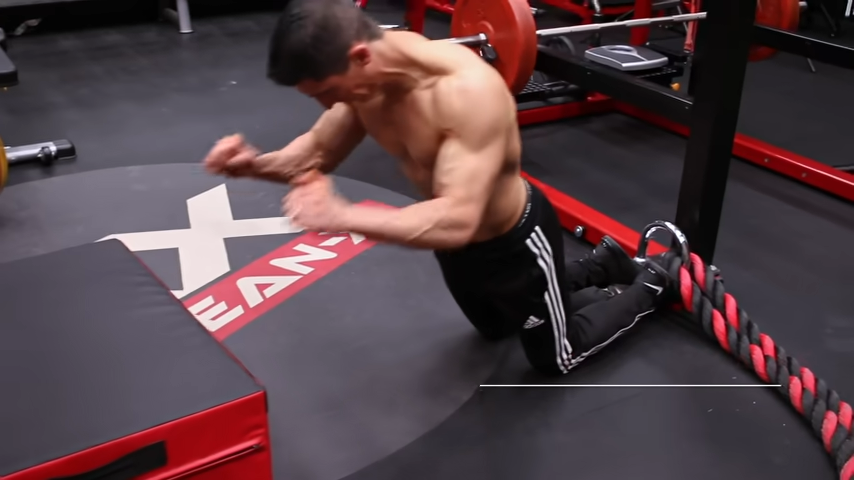
The Glute Ham Raise incorporates both hamstring activation and glute activation. More importantly, it focuses on the function and mechanics of the muscles.
The focus here is to allow the glutes to drive the function of the hamstrings by contracting and stabilizing first. This will ensure that you’re going to get a better and safer contraction of the hamstrings.
PULL-UPS

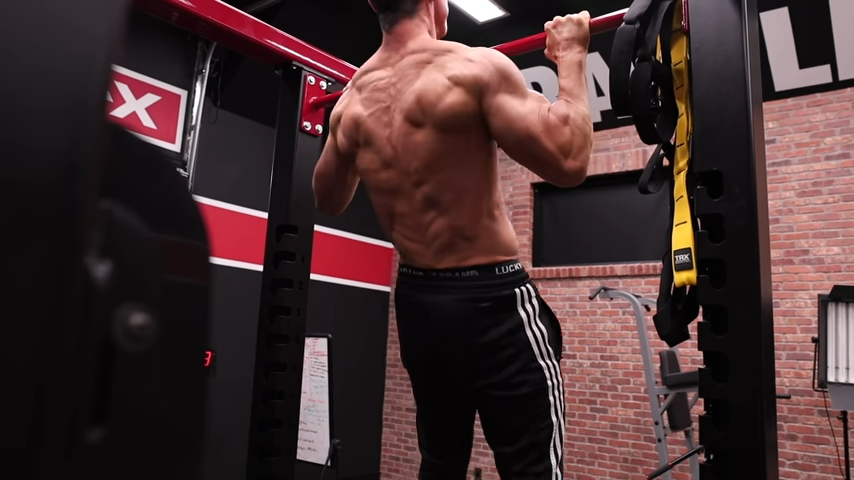
Now, we move to our first upper body exercise, which is one of the best ways to build major muscle in the back.
Pull-Ups hit the entire back while stabilizing those important lower lumbar paraspinal muscles.
HUMAN PULLOVER

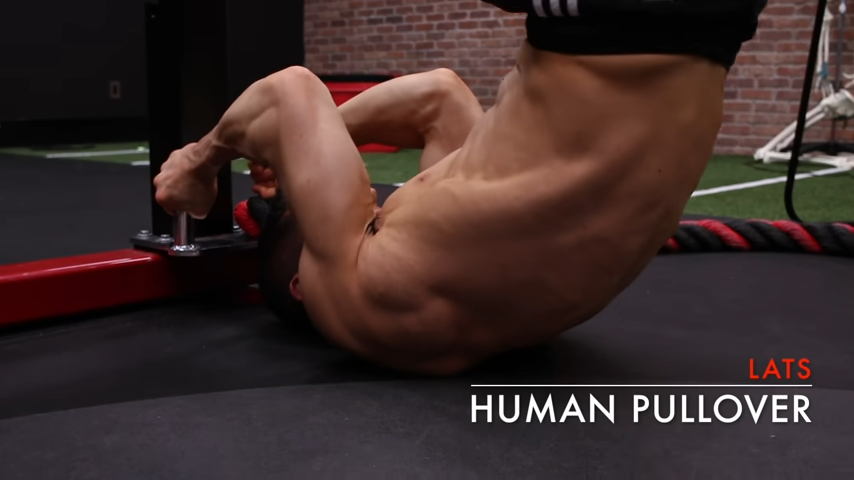
Despite a lot of talk on YouTube, the Human Pullover or Human Flag exercise is NOT an ab exercise – it’s a back exercise.
Specifically, the Human Pullover targets your lats from the top position to the bottom position, ensuring your able to overload the muscle. It’s also a great way to improve upper body muscle endurance.
Since you’re utilizing your entire body weight and hitting the largest target muscle from the angle that matters, you’ll see big gains in strength and muscle development.
I must stress this: Do not curl your trunk up by using your abs. Instead, think of it like a Straight Arm Pushdown and mimic that to get your body up.
CLASSIC CHIN UP


Continuing with our pulling exercises, we have the Chin-Up. This one movement can target the lats while also engaging the biceps. As far as muscle toning goes, the traditional Chin-Up can’t be beat.
One thing to keep in mind is that when you do the exercise, don’t get too close to the bar. Maintain some distance between your straight body and the bar at the top.
REVERSE HYPEREXTENSION

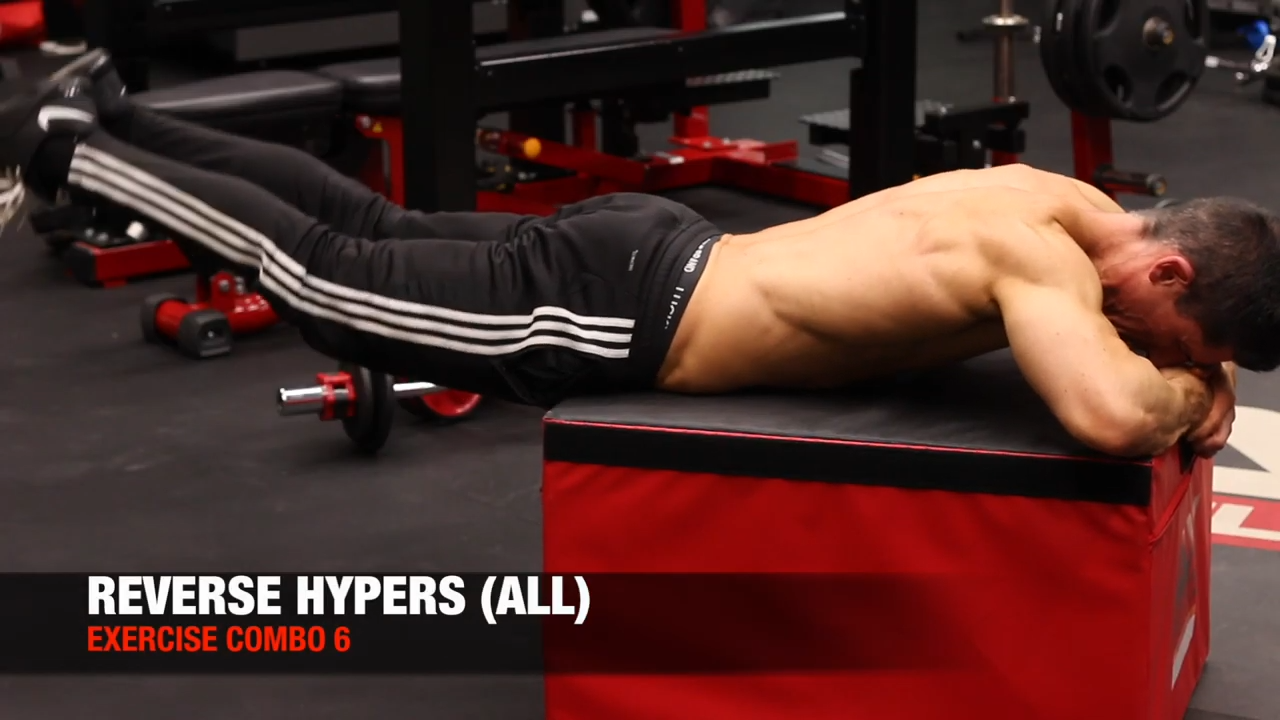
We finish up our pulling exercises with Reverse Hypers, a corrective exercise that is going to do wonders for your back.
Lay face down over any stable surface and drive the lifting of the leg by first contracting the glutes and then allowing the low back to take over from there.
PUSHUPS

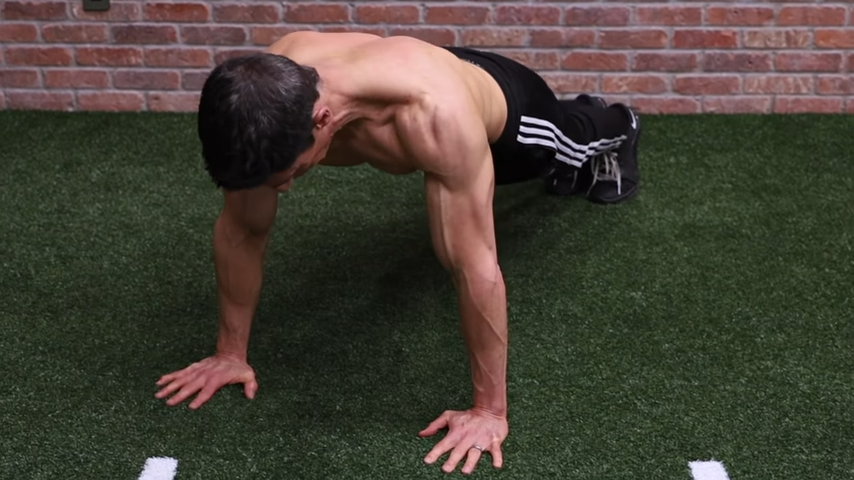
Now, let’s switch to the other side of the upper body with our first push exercise: Regular Push-Ups.
This is one of the best overall exercises, especially for starting on a journey for muscle strength. Right from the get-go of the pushup position, this exercise taps into your pecs while demanding a lot from the core muscles, shoulders, and triceps.
It’s those last two inches of extension while doing the Push Up that matter if you want to get a complete chest contraction. Keep that in mind for all repetitions.
But just as important is variation and challenging yourself. There are plenty of Push-Up variations outside of the Standard Push-Up including the following:
- Pike Push-Up
- Decline Push-Ups
- Uneven Push-Ups
- Plyometric Push-Ups
The idea is that when you’re great at one type of Push-Up, you should try to advance to another type that’s a bit more challenging.
For example, if you’re able to do 15 Push-ups in standard form, then try something new in your next workout such as 20 Wide Push-ups or 5 Clap Push-ups.
That’s what is so great about this exercise: There’s so much variety.
DOORWAY FACE PULL

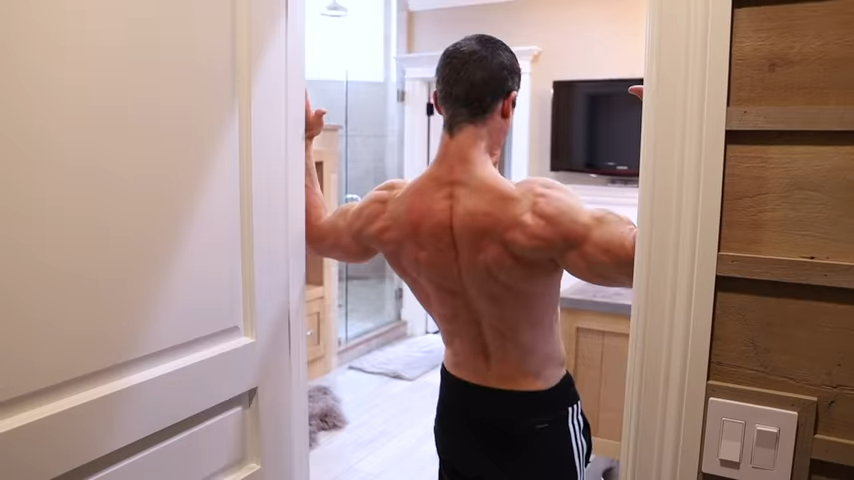
No workout, especially not one considered the best calisthenics workout, would be complete without some form of Face Pull.
Thankfully, I have a bodyweight version of a Face Pull that you can do in a doorway.
You can easily overload the muscles, providing the same benefits that you would get from a regular Face Pull.
HANDSTAND PUSH UP

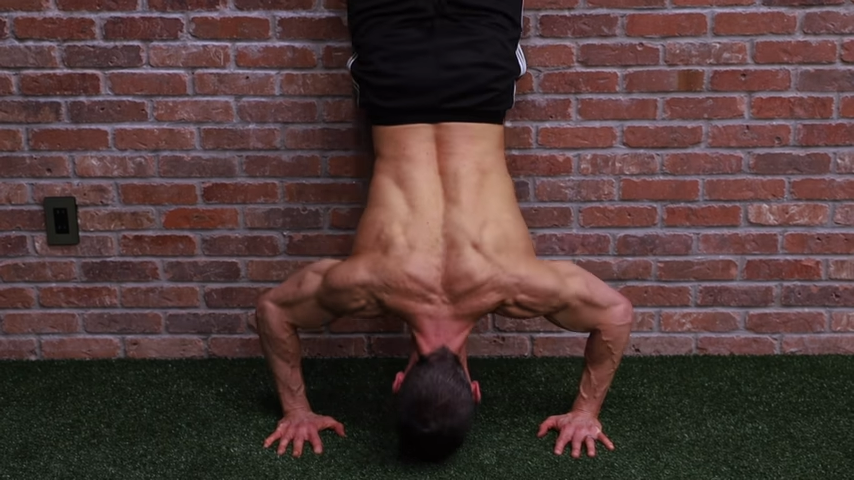
Admittedly, this might be an exercise that you have to build up to, but I recommend it for every program because of how well it builds the shoulders.
The Handstand Push-Up doesn’t require any additional equipment, just a sturdy wall to balance yourself.
The thing I love about this exercise is that it’s one of the very few opportunities you have to do a shoulder exercise with an overhead pressing range of motion where your hands are still in contact with the ground.
This activates the kinetic chain in a different way, and you don’t need to have a ton of flexibility to do it.
HANGING LEG RAISE

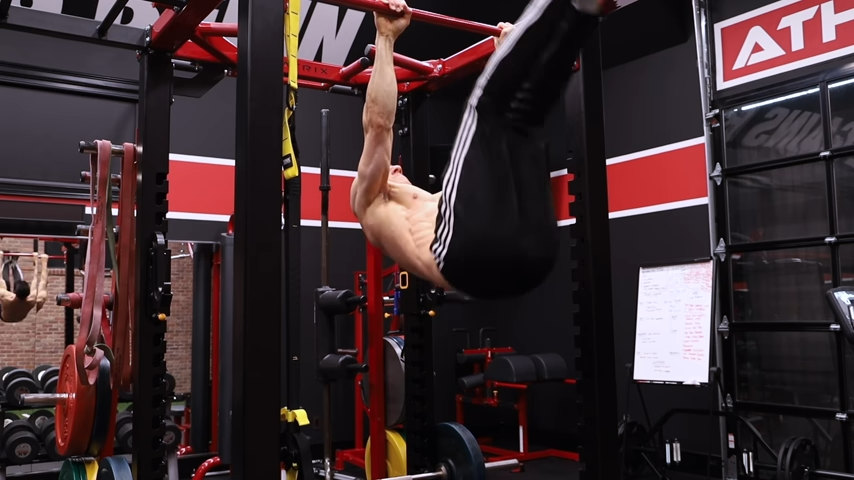
Now, let’s move to the core muscles with the Hanging Leg Raise. By taking the weight of the legs and lifting them up, you’ll create the necessary overload to work your abs.
When it comes to the abs, you want to maximize your resistance because the more they grow, the more they pop, particularly at lower body fat levels.
DIPS

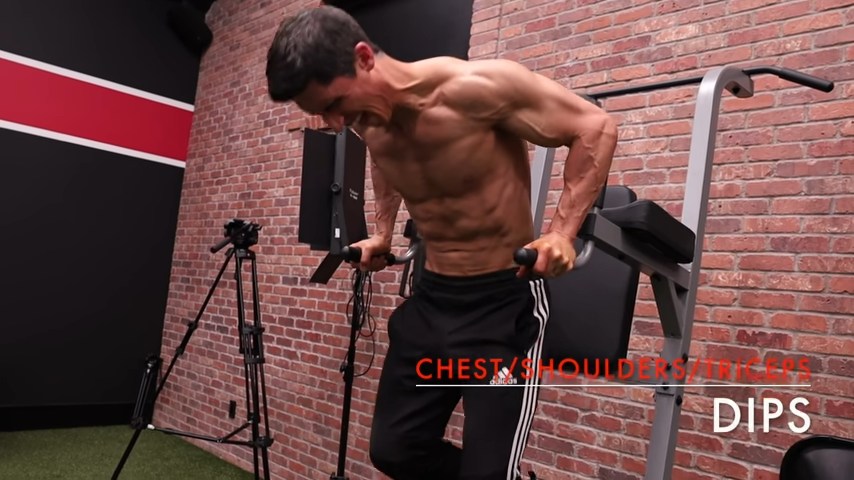
Let’s wrap up my top 11 body weight exercises with an exercise for the arms.
Dips are a great chest, shoulder, and triceps builder. This is because you’re suspending your entire body weight and you’re not able to offload some of your own body weight like we do in the pushup.


As far as what you need, this is another minimal equipment exercise. While a dip station would be preferable, you can also use the corner of a kitchen counter.
30-DAY CALISTHENICS WORKOUT PLAN
For this 30-day calisthenics workout plan, you’ll receive TWO full-body workouts that you will alternate every other day.
These are not your typical 3 day/week push-pull leg splits. Far from it!
And these aren’t just randomly chosen calisthenics exercises; each one has been selected to fit one of the major functions that I mentioned above:
- Lower Body Anterior Chain
- Upper Body Upper Push
- Lower Body Posterior Chain
- Upper Body Pull
- Abdominal Circuit
- Corrective Exercise
In fact, I’ve laid out the exercises in this exact format to make it easier to understand.
What’s more, you’ll find there is a both a beginner exercise module and advanced calisthenics workouts. Choose the route that works best for your current fitness level.
Keep these rules in mind before you get started:
- There are no rest periods at any point during each workout, which is the reason we are staggering upper and lower body.
- You’ll perform each exercise combination for ONE MINUTE with the goal of no rest.
- The exercises are staggered in such a way that it should allow you to continue to move through the workout even though you’re fatigued from prior exercises. This gives you the chance to train to a point of progressive overload.
You will alternate your “A” and “B” workouts. For example, if you start on Monday with the training session, you will alternate Monday, Wednesday, and Friday. Pick the days that work best for you to do three sessions per week.
Here is a full layout of the exercises that you’ll be doing, based on your fitness level.
LOWER BODY ANTERIOR CHAIN
As mentioned above, you’ll have one minute for each exercise combo.
ALTERNATING SINGLE LEG LOW BOX SQUAT (ADVANCED)


Exercise notes: Perform one-legged squats from a low box or piece of furniture.
ALTERNATING SINGLE LEG HIGH BOX SQUAT (BEGINNER)


Exercise notes: You can turn this into an assisted squat by using an elevated box or piece of furniture like a kitchen chair.
1 1/2 BOTTOMED OUT SQUATS (ALL LEVELS)


Exercise notes: These are like Body Squats or Air Squats but they emphasize the parallel-to-below-parallel range of motion of the exercise, which is usually the weakest area of basic squats.
JUMP SQUAT (ALL LEVELS)

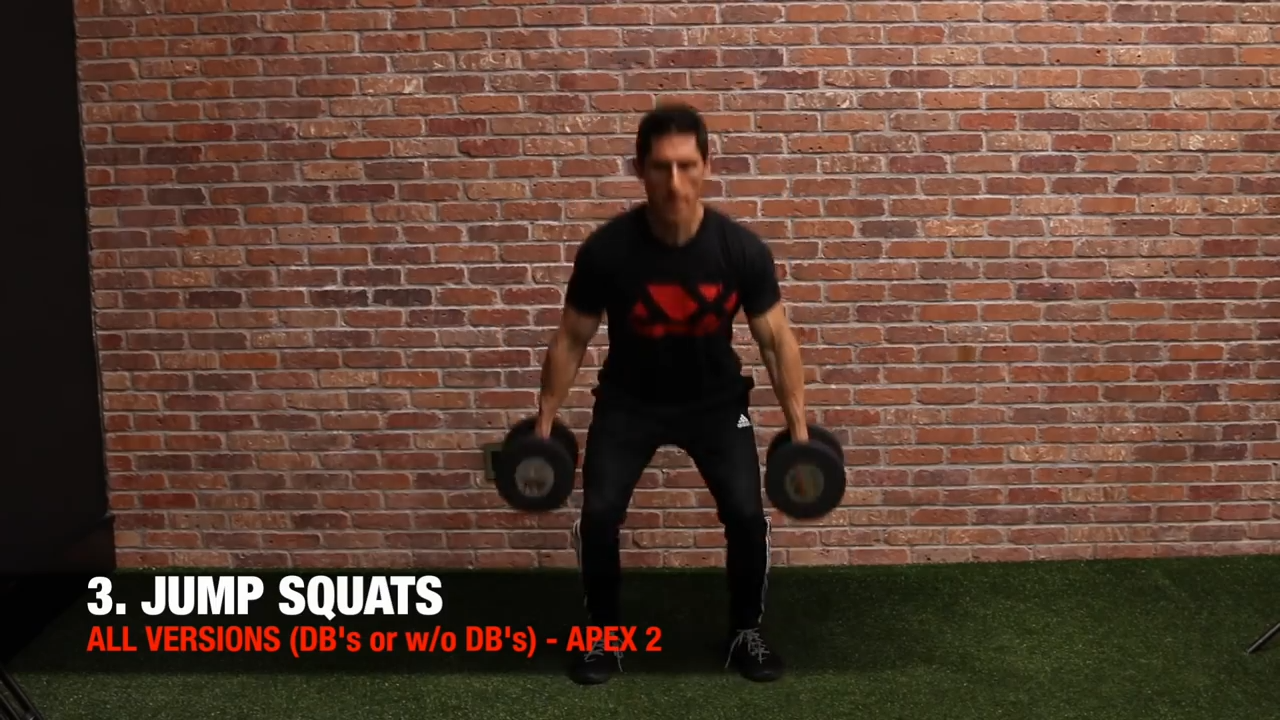
Exercise notes: This is one of the toughest leg exercises to end the circuit with, but try to keep up this squat position for one minute.
UPPER BODY UPPER PUSH
Remember, there’s no rest here. Move right into the upper push exercises.
Again, pick the exercises that match your fitness level.
HANDSTAND PUSHUP (ADVANCED)


Exercise notes: Advanced movements like this are great for the shoulder muscles, but only if you are ready to do them. Start on all fours with knees bent and feet touching the floor, palms flat on the ground. Push your upper body diagonally back and away from your hands, ending up with arms straight.
POWER PUSHAWAY (BEGINNER)


Exercise notes: This basic bodyweight exercise is still working the shoulders just like the Handstand Pushup. It doesn’t require you to lift as much of your own bodyweight off the ground, but still gets the job done.
ROTATIONAL PUSHUP (ADVANCED)

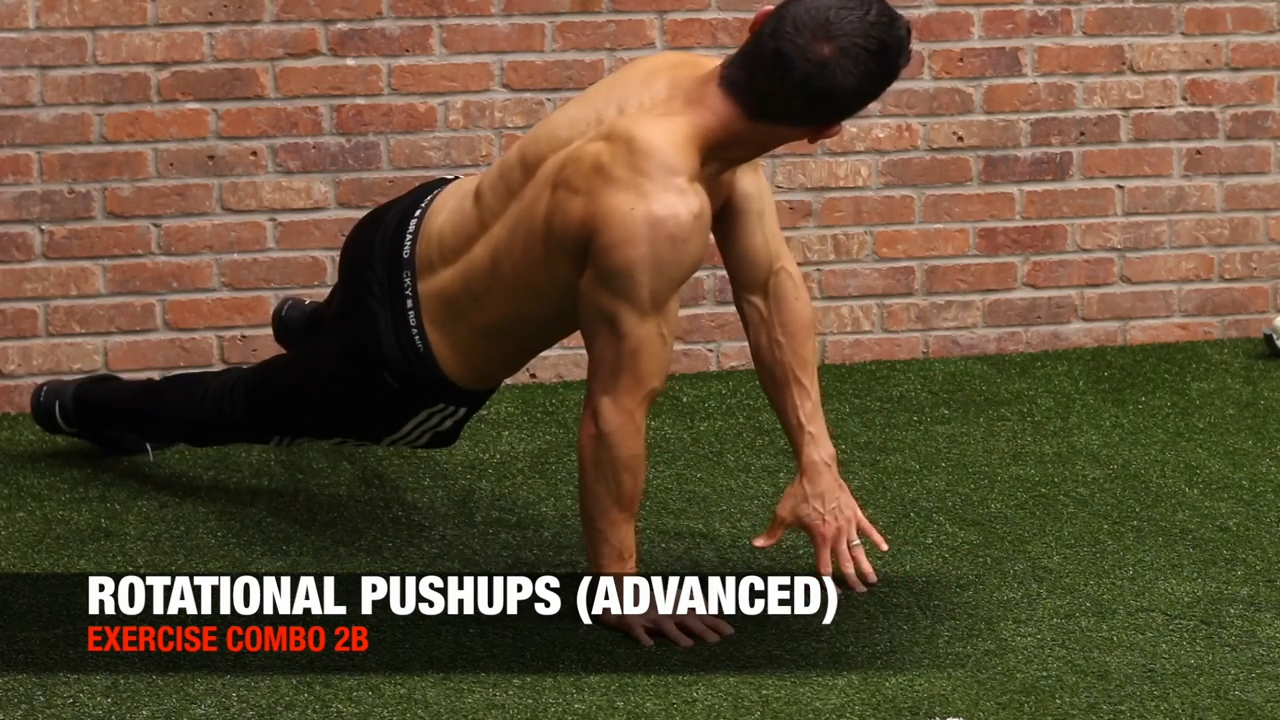
Exercise notes: The Rotational Pushup is chest focused but it also includes some additional adduction.
KNEE ROTATIONAL PUSHUP (BEGINNER)

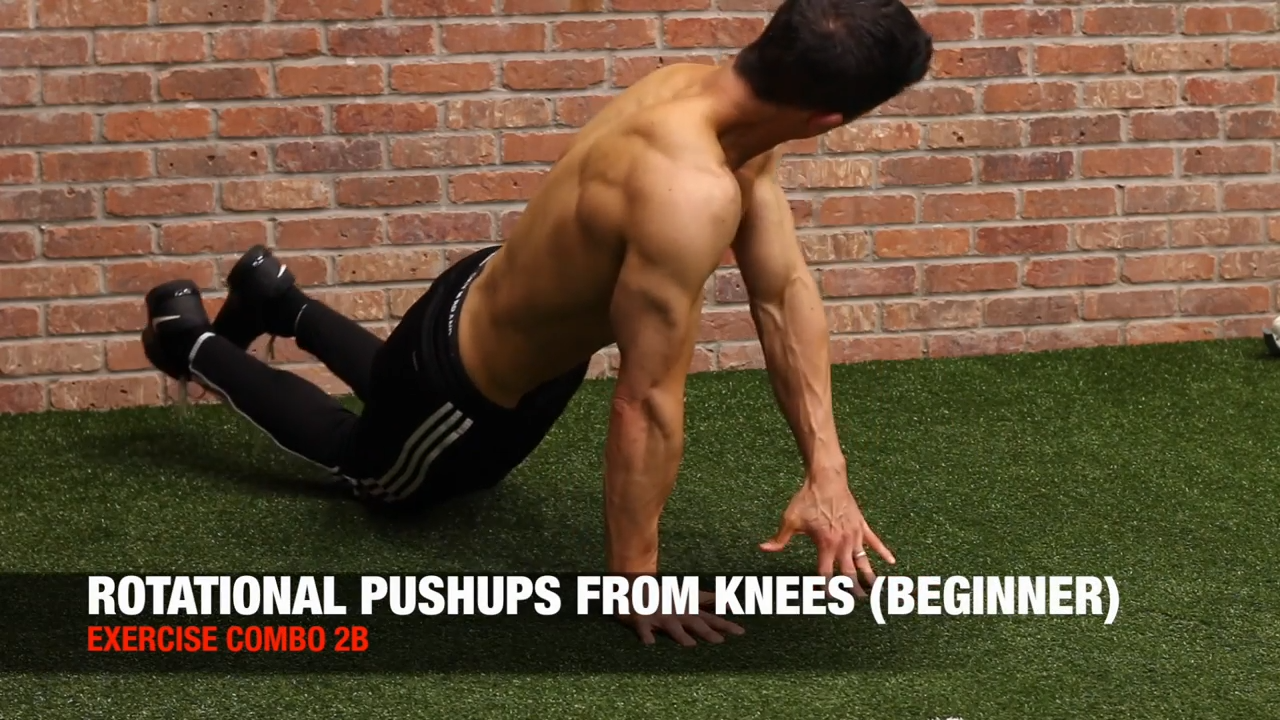
Exercise notes: If you can’t do the Rotational Pushup, simply drop down to your knees and perform the same movement.
COBRA PUSHUP (ADVANCED)

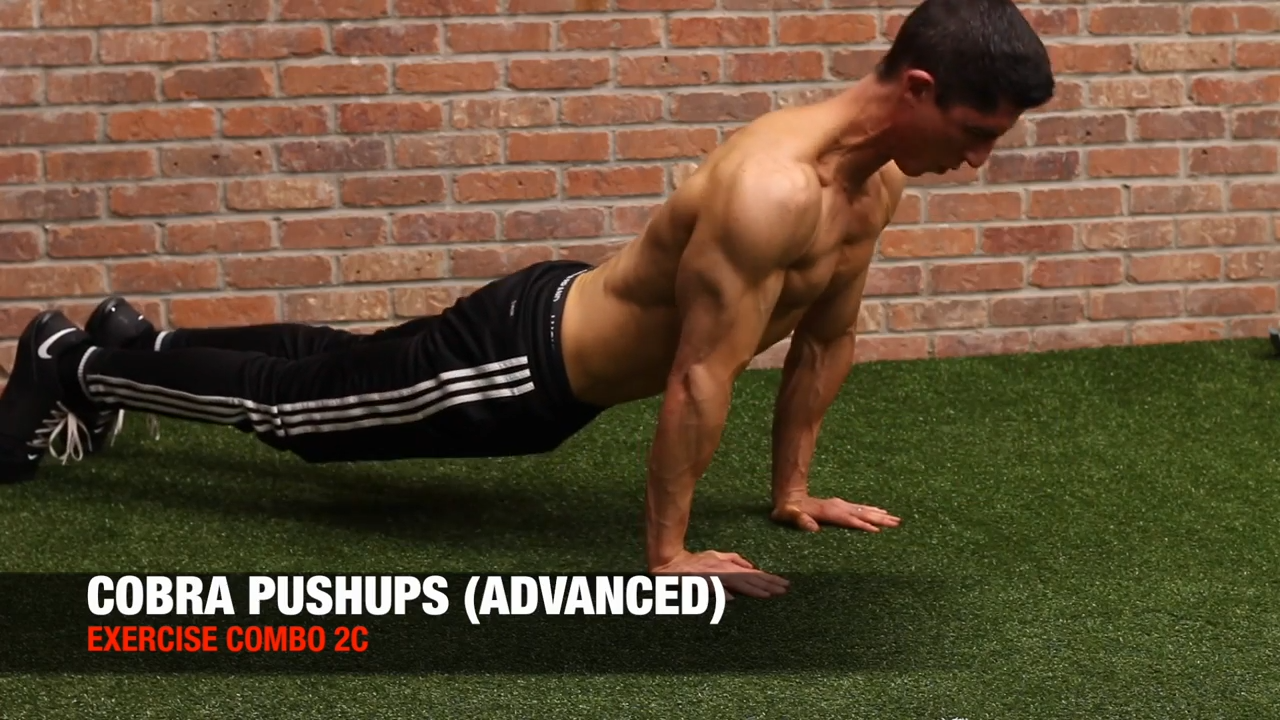
Exercise notes: This trains the long head of the triceps in its more contracted position. Starting position is with the body in an elevated plank position. Then bring the torso down and ‘through’ the arms, arching the back and bringing the chest forward.
KNEE COBRA PUSHUP (BEGINNER)


Exercise notes: This can be done from your knees if you’re a beginner and you’ll get the same benefits.
LOWER BODY POSTERIOR CHAIN
Next up, you’ll move right into posterior chain focused exercises for the lower body portion of this calisthenics workout plan.
For these exercises, there will be more of a focus on glute, not quad, dominance.
ALTERNATING SINGLE LEG HEEL TOUCH SQUAT (ADVANCED)

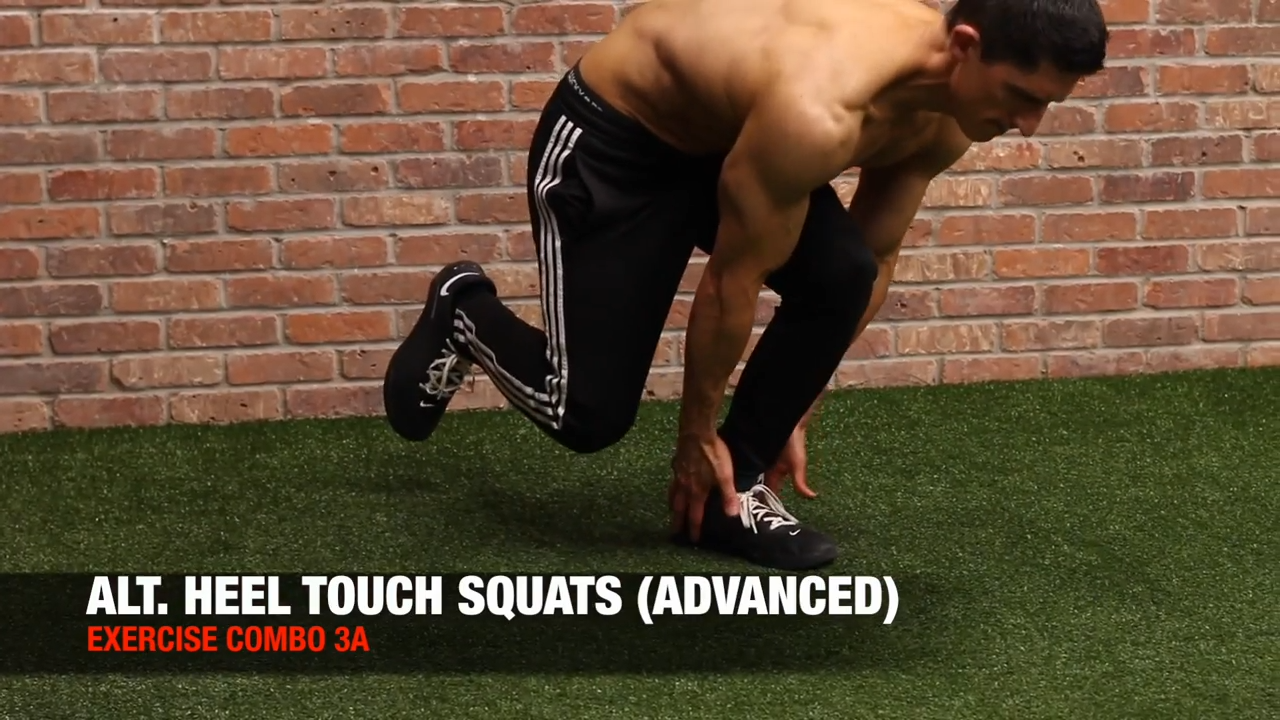
Exercise notes: Just by leaning forward you’ll shift a lot of the focus onto the glutes. Try to touch both hands to the outsides of your heels and come back up.
ALTERNATING KICKSTAND HEEL TOUCH SQUAT (BEGINNER)


Exercise notes: If you need a bit of extra assistance with balance, do the kickstand variation. One of your feet will take on 10-15% of your body weight.
ALTERNATING SPRINTER LUNGE (ALL LEVELS)

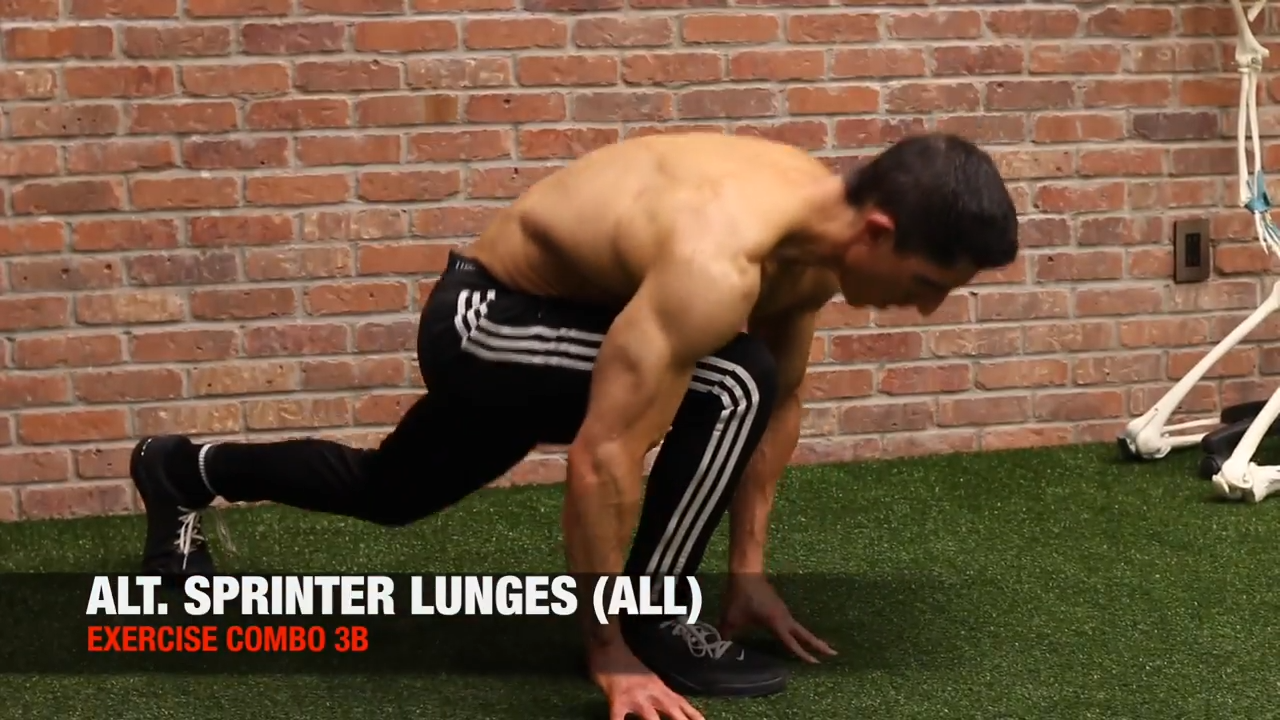
Exercise notes: Simply lean forward in the traditional lunges position, and you’ll feel the contraction in the glutes.
LOW PLYO SPRINTER LUNGE (ADVANCED)


Exercise notes: This takes the same Traditional Lunges with a forward lean position, but turns the move into Jump Lunges, jumping into the air and switching legs.
HIGH PLYO SPRINTER LUNGE (BEGINNER)


Exercise notes: If you’re a beginner, you can switch to a higher elevation up out of the Jump Lunges.
UPPER BODY UPPER PULL
Guess what – Still no time to rest here. Keep going into the upper body pull combo.
You’ll see that you do need some additional equipment, but I’ve also included for household objects.
PULLUP (ADVANCED)

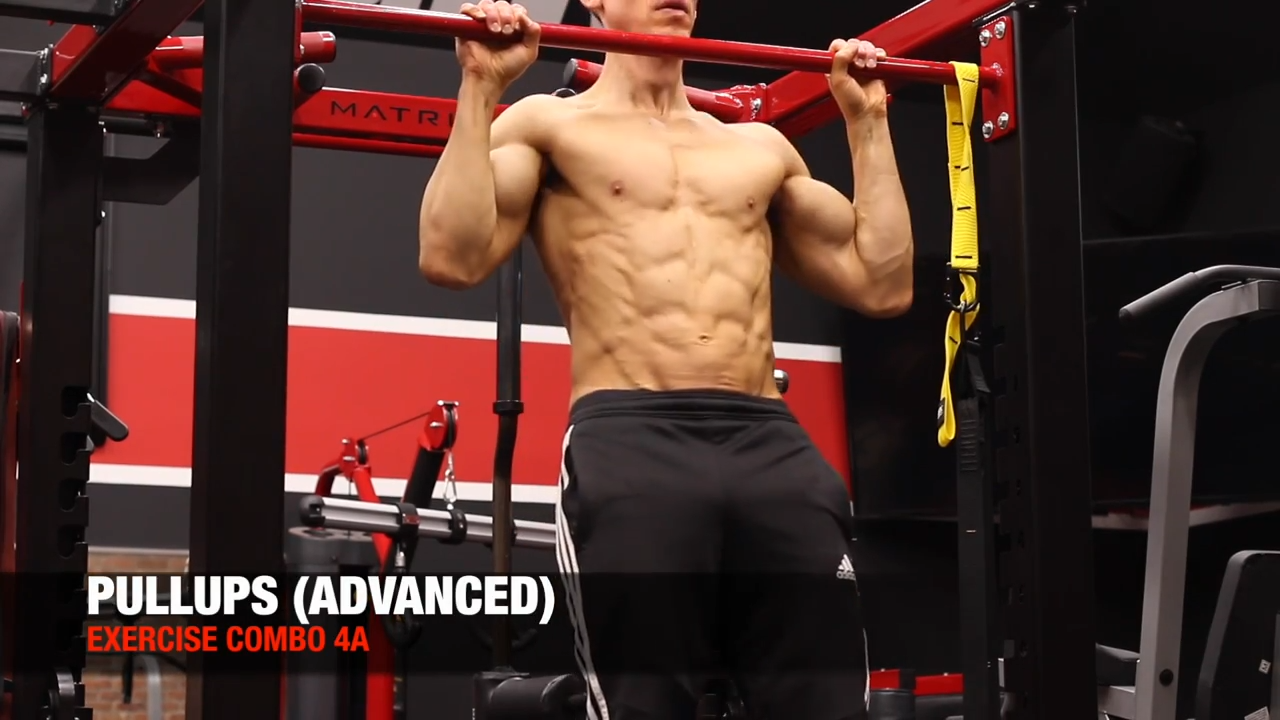
Exercise notes: Pull-ups are a classic pull exercise. If you have access to pull-up bars, that’s perfect. If not, I have a variation you can do.
SEATED PULLUP (BEGINNER)


Exercise notes: You can perform the Assisted Pull-up by placing a dowel, broomstick, or exercise bar across the top of two couches or two chairs. Position your legs in front of you and lean back as you pull up.
HUMAN PULLOVER (ADVANCED)


Exercise notes: To ensure your lats are doing all the work, try to pull your body up by pulling the arms into an immovable object. Do not focus on moving your knees toward your chest.
CALISTHENICS SLIDING PULLDOWN (BEGINNER)

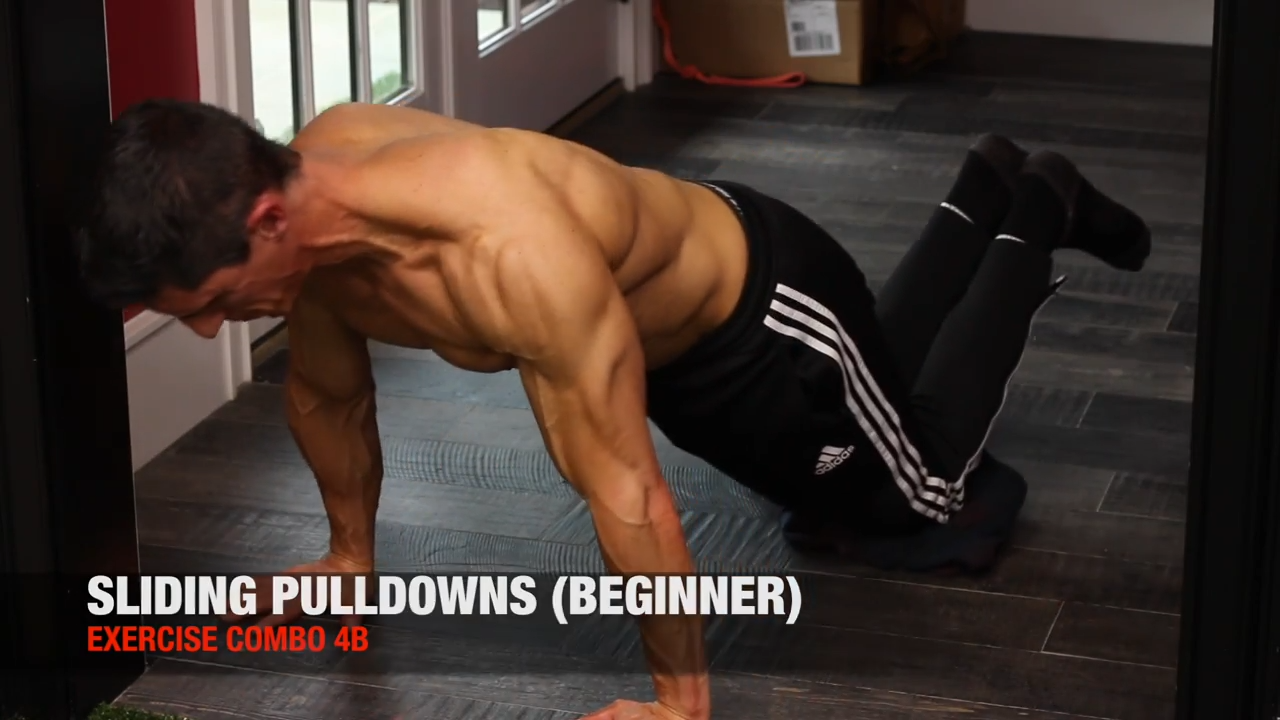
Exercise notes: Use a slick surface you can slide on like a hardwood or a tile floor. Allow your feet to drift out, get that stretch in the lats and pull back in.
INVERTED CHIN CURL (ALL LEVELS)

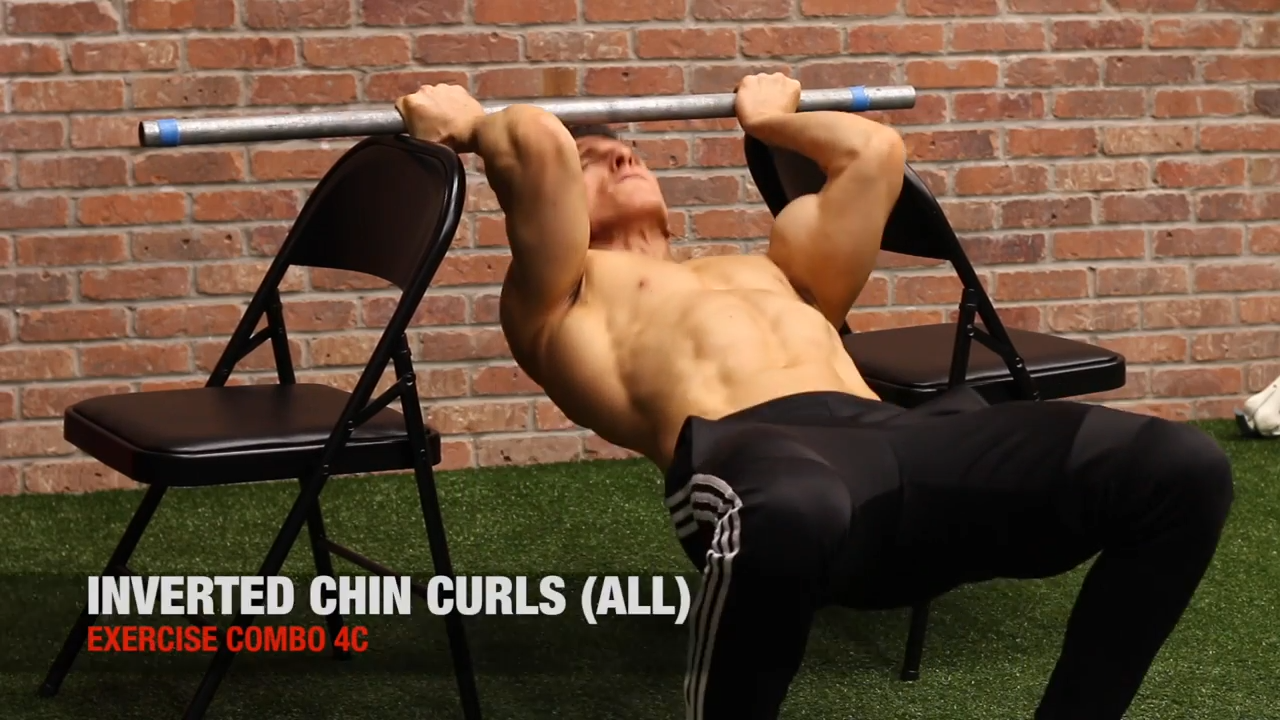
Exercise notes: Pull yourself up as if you’re curling your body up to the bar to engage the biceps.
CORE CIRCUIT
Stay strong and keep pushing on with these exercises focusing on the core muscles. You’re almost finished!
REVERSE CORKSCREW (ALL LEVELS)


Exercise notes: Engage the lower abdominal muscles while focusing on the bottom up rotation to hit the entire core musculature.
BLACK WIDOW KNEE SLIDE (ALL LEVELS)

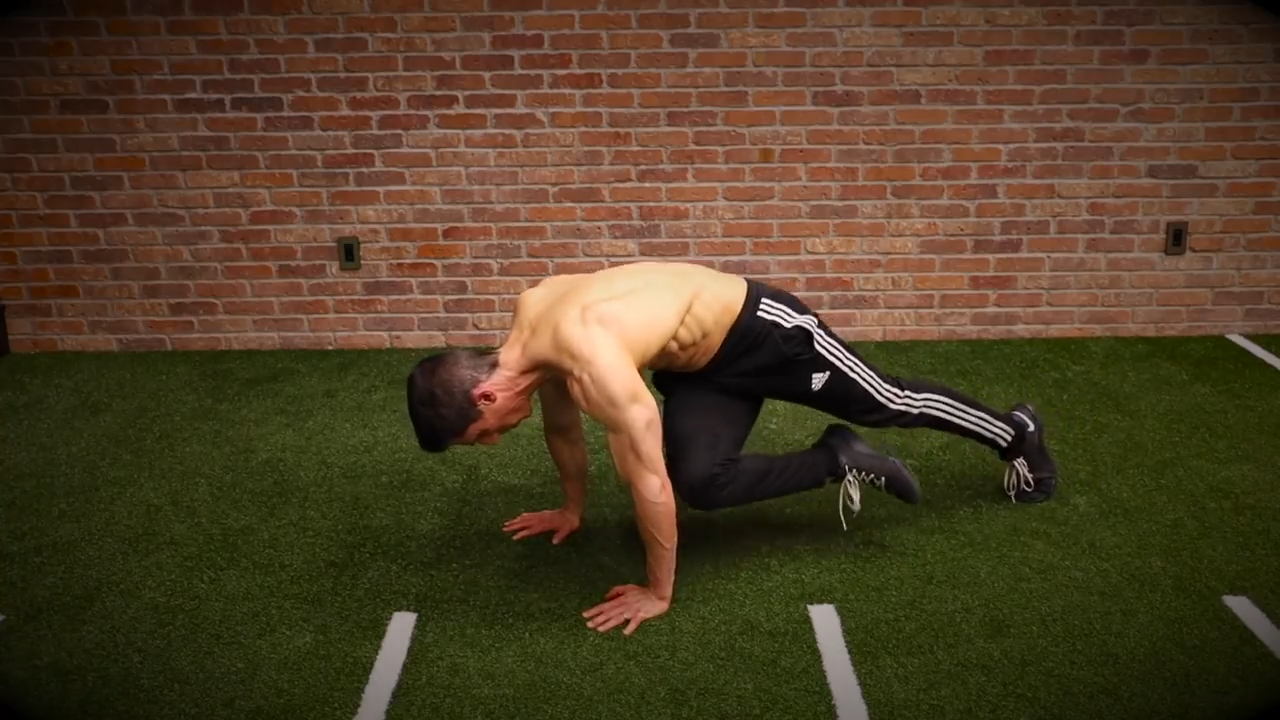
Exercise notes: Drive your knee in toward your elbow, and slide it up to get a bit more flexion through the spine, which engages both upper and lower abs.
LEVITATION CRUNCH (ALL LEVELS)

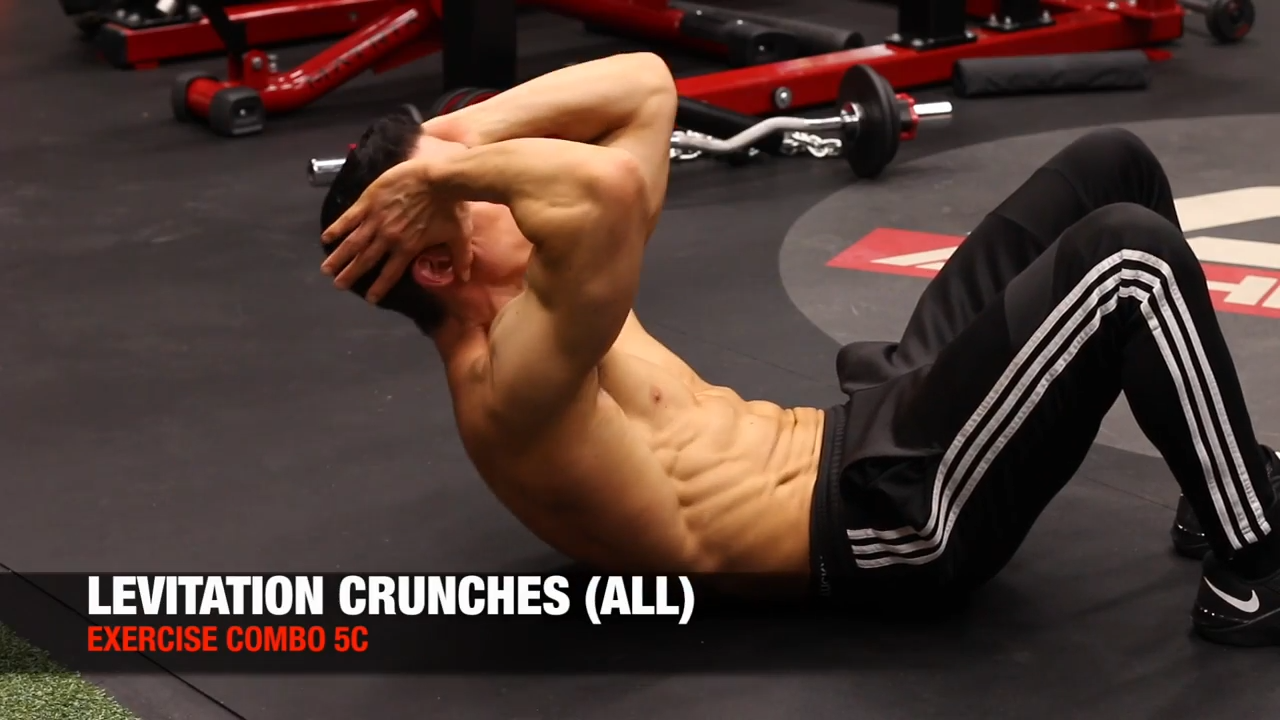
Exercise notes: Elevate your scapula and shoulder blades off the ground, but do not curl them up toward your knees.
CORRECTIVE
All right, guys, you’re going to finish strong with one of my favorite corrective exercises.
ANGEL AND DEVIL (ALL LEVELS)

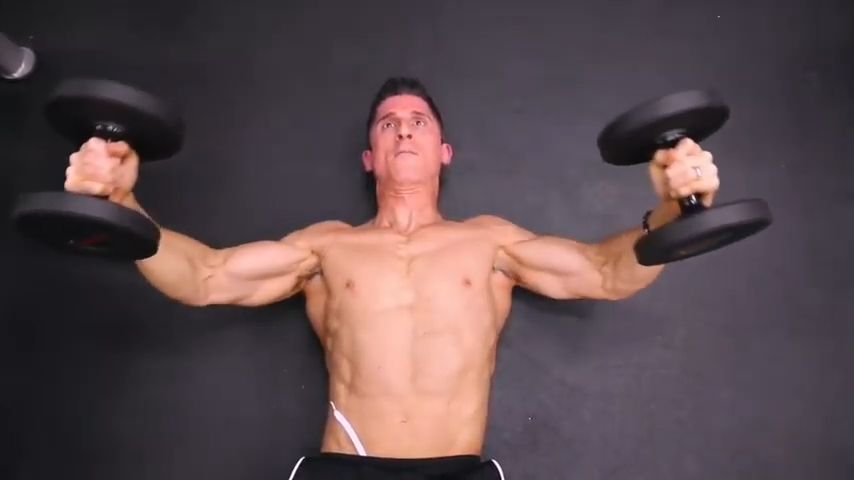
Exercise notes: Elevate your quads off the ground by engaging the glutes and low back. The rotation of the arms takes our shoulders through full rotation to work not only the rotator cuff but also the scapulae and mid back muscles.
As before, select the workout that is aligned with your current fitness level. If you start with the beginner workout routine, that’s okay! You’ll be doing the advanced level calisthenics exercises in no time.
LOWER BODY POSTERIOR CHAIN
In Workout B, we’ll be starting with the lower body posterior chain series, but don’t worry, we’ll be hitting anterior chain later in the workout.
Just like with your first calisthenics workout plan, choose the exercises that are best for your fitness level.
SLICK FLOOR BRIDGE CURL (ALL LEVELS)

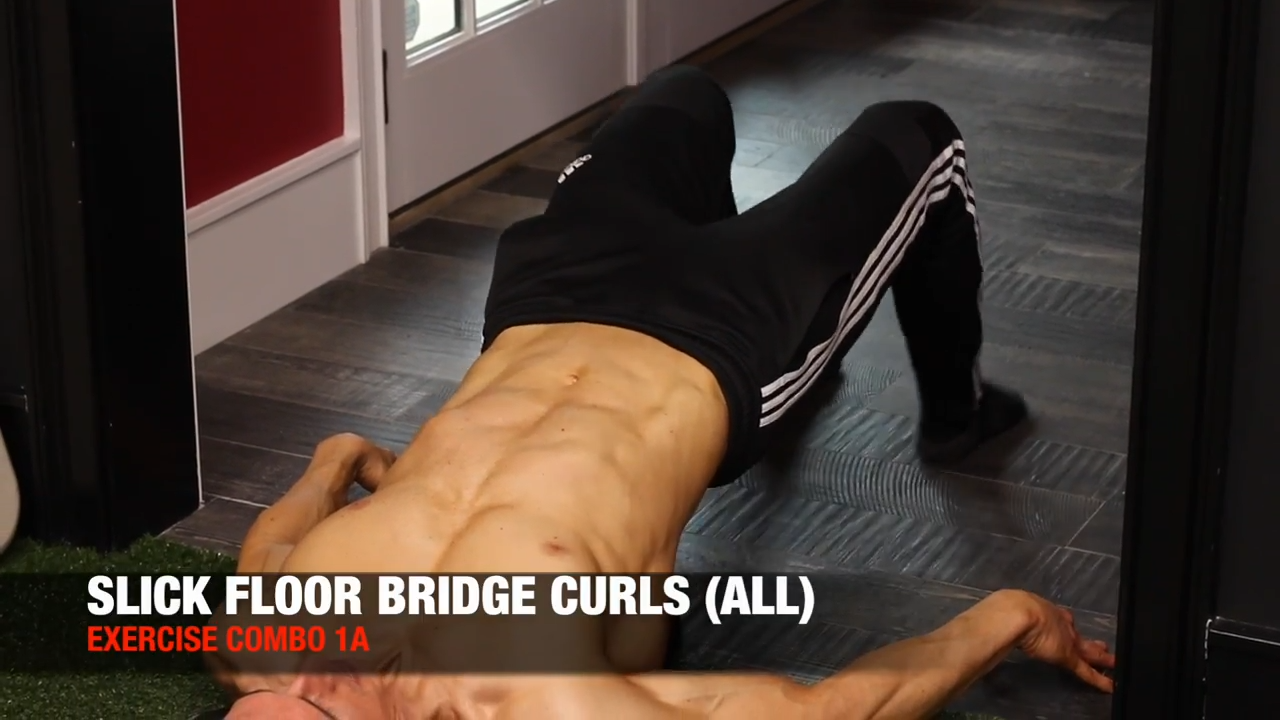
Exercise notes: Use socks on a slick surface like a hardwood or tile floor as you engage both your hamstrings and your glutes together at the same time.
LONG LEG MARCH (ALL LEVELS)


Exercise notes: This focuses on the entire posterior chain as you engage your glutes and legs.
HIGH HIP BUCK (ALL LEVELS)

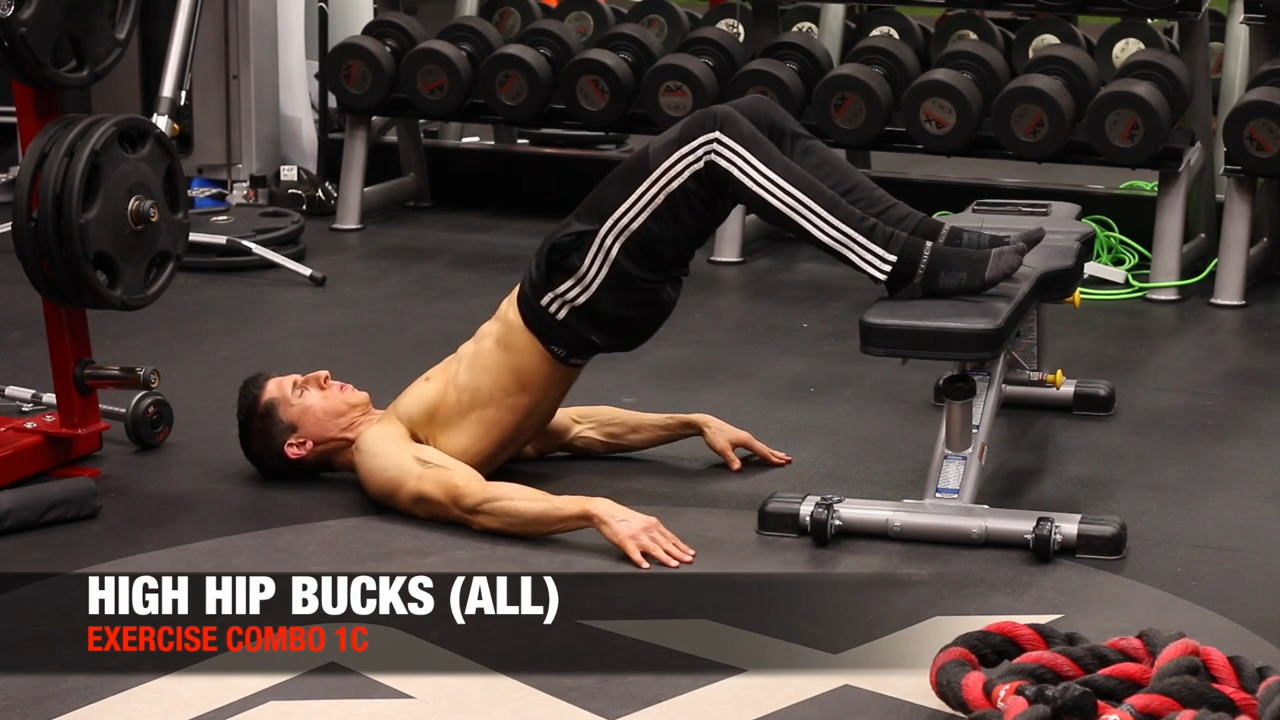
Exercise notes: Put your feet on any surface and allow the glutes to drive the movement.
UPPER BODY UPPER PUSH
While Workout A was more focused on the shoulder muscles, Workout B is going to go heavy on the chest.
Don’t worry though, we aren’t forgetting about the posterior shoulders and triceps with these strength-training movements.
VARIABLE WALL PUSHUP (ADVANCED)


Exercise notes: As you fatigue, simply walk yourself down the wall to allow you to continue, knowing that the flat variation is going to be easier than the decline variation.
KNEE DECLINE TO FLAT PUSHUP (BEGINNER)

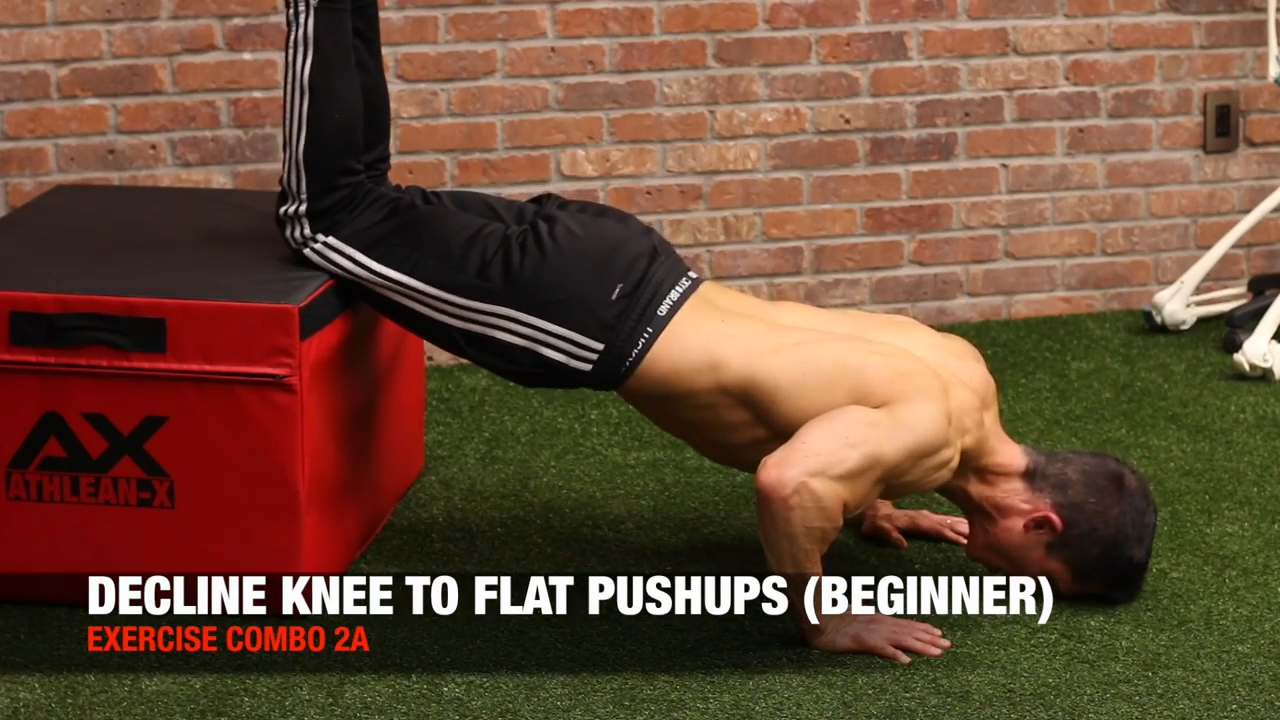
Exercise notes: If the wall version is too hard, you can simply put your knees up onto any surface such as a couch or chair.
ALTERNATING BODYWEIGHT SIDE LATERAL RAISE (ADVANCED)

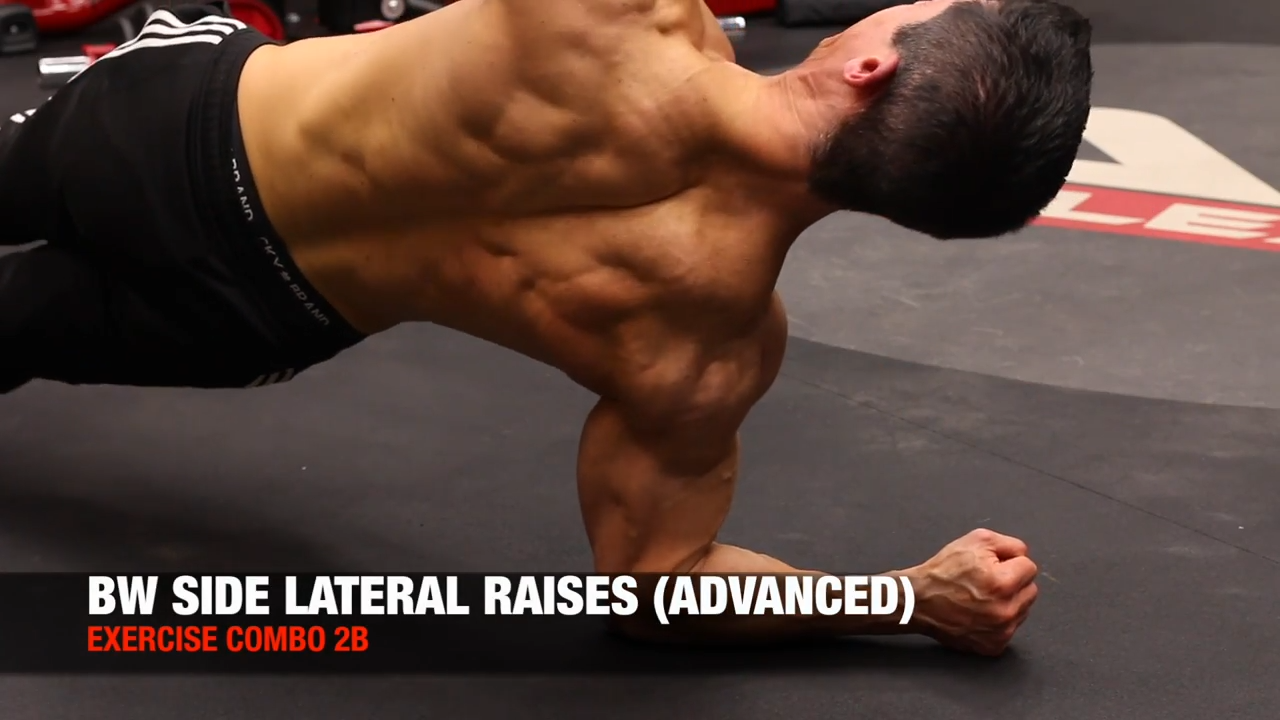
Exercise notes: You’ll be moving the body around a fixed limb to get relative abduction of the arm. This means that we are training the shoulder by moving the body away from the arm.
KNEE BODYWEIGHT SIDE LATERAL RAISE (BEGINNER)

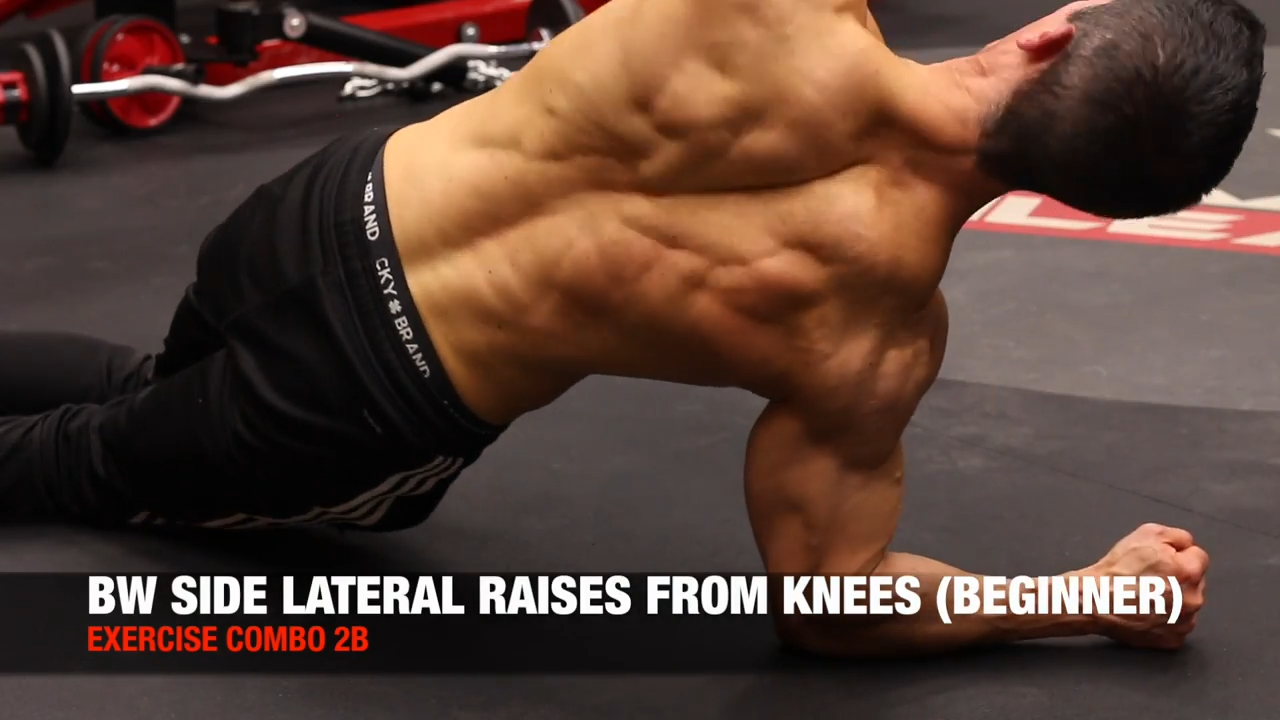
Exercise notes: Beginners can make this exercise easier by doing it from the knees.
CALISTHENICS TRICEPS EXTENSION (ALL LEVELS)

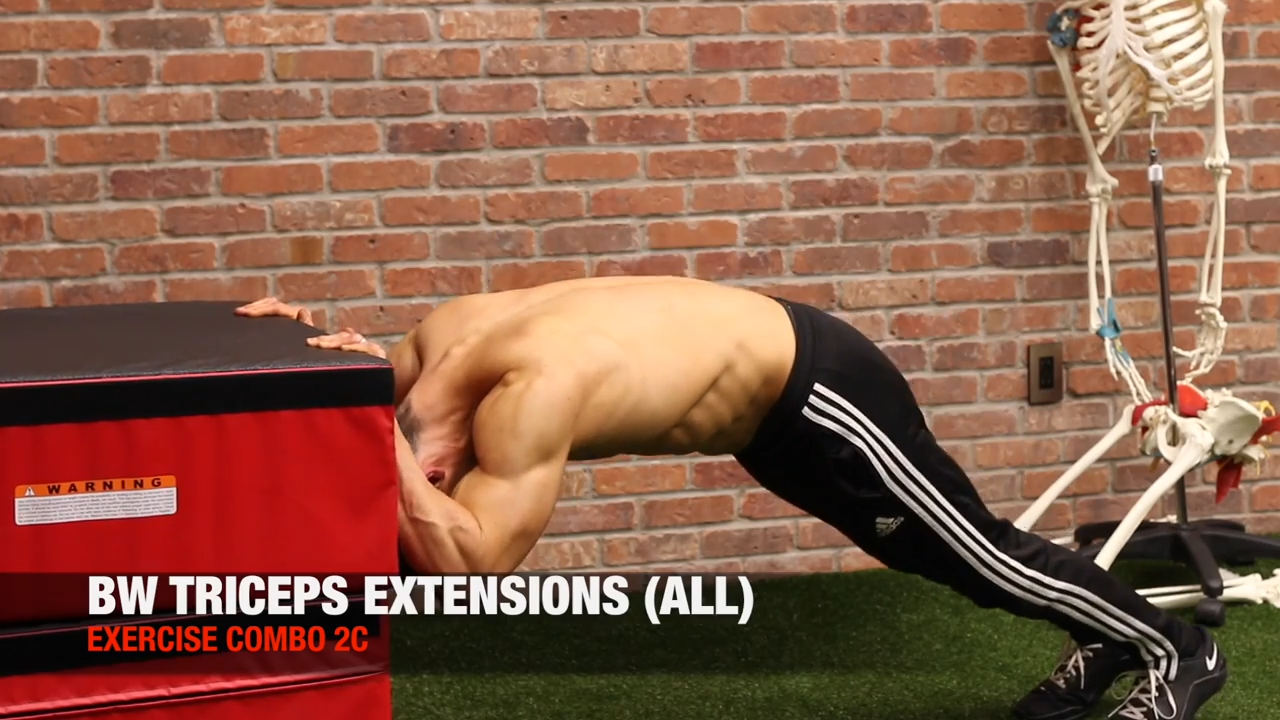
Exercise notes: This exercise will put the long head of the triceps on stretch as you dip down and dive your head down underneath.
LOWER BODY ANTERIOR CHAIN
The lower body anterior chain exercises in the first calisthenics workout above were mainly focused on squats, but not here.
In Workout B, we’re going to hit the quads in more lunge biased exercises including single leg exercises.
ALTERNATING CROSSOVER STEP UP (ALL LEVELS)

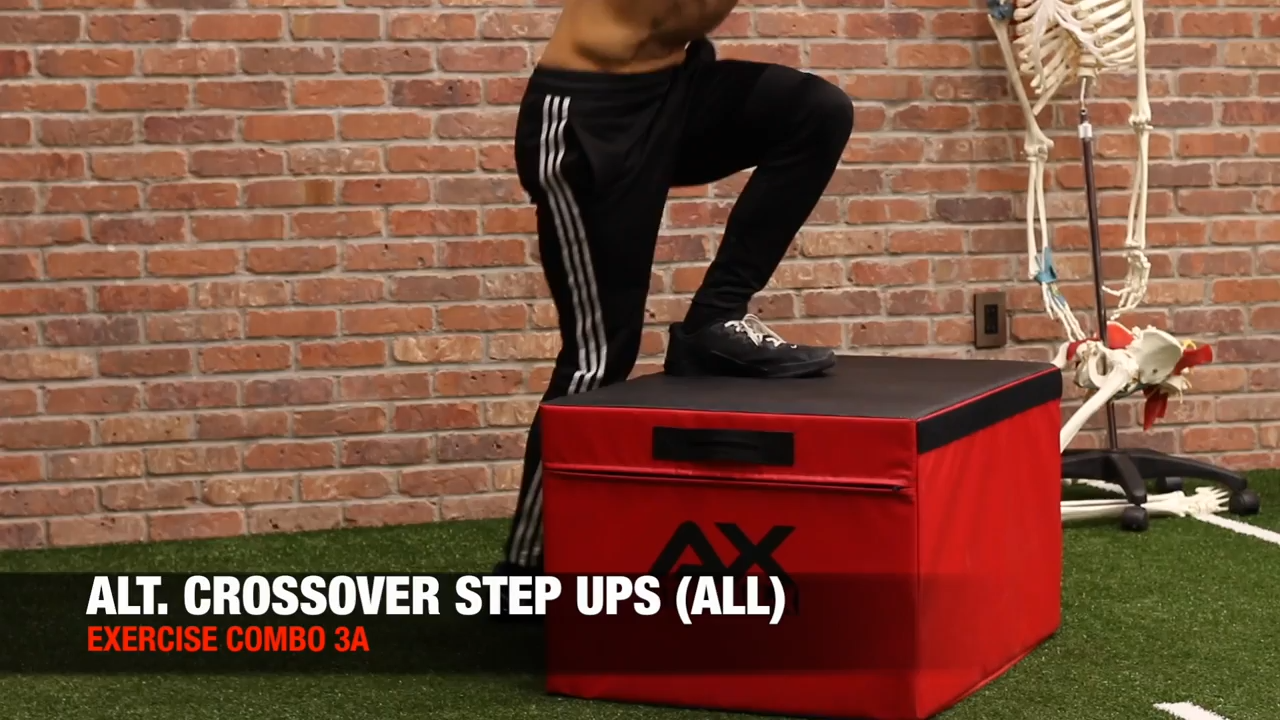
Exercise notes: Try to keep your torso upright as much as possible. The slight crossover of the leg behind you allows you to reload the quad more in the bottom position so you can drive up a bit more forcefully.
ALTERNATING REVERSE LUNGE (ALL LEVELS)

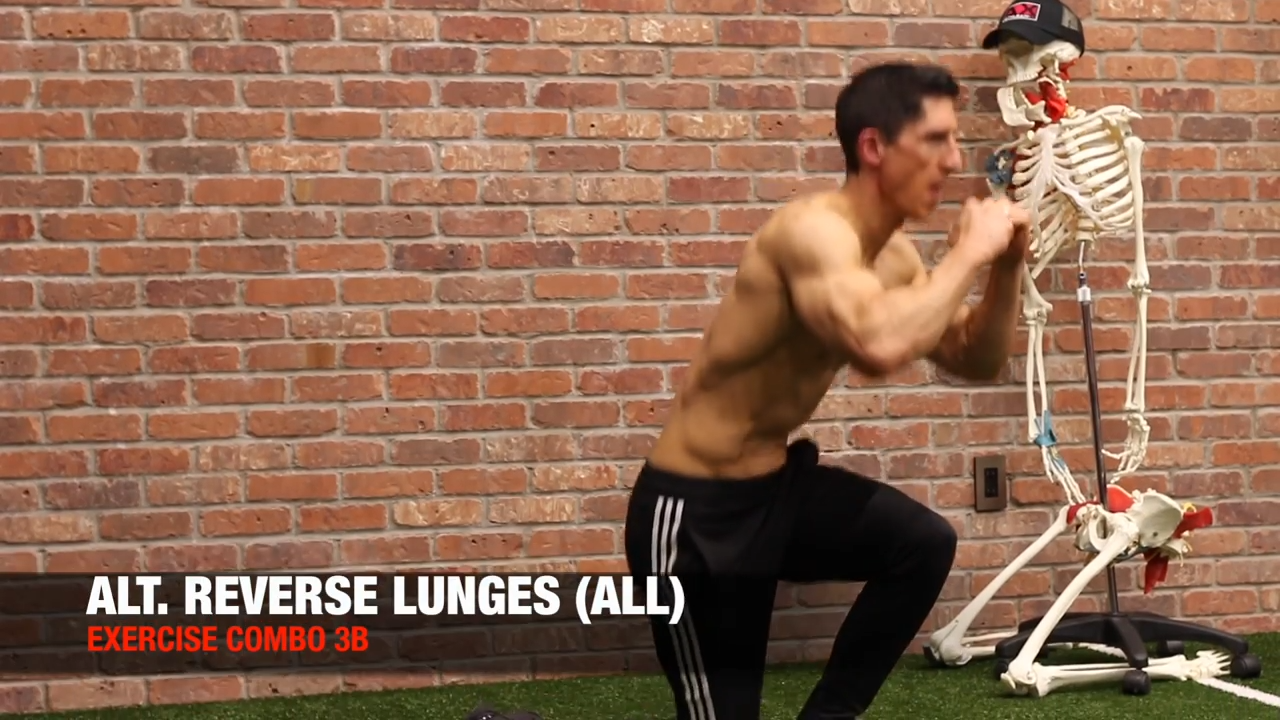
Exercise notes: Even if you have knee problems, you’ll find that this exercise will work for you regardless of what level you’re performing it at.
SPLIT SQUAT JUMP (ALL LEVELS)


Exercise notes: Just like in the other work, you’ll be performing something like Jump Lunges. It’ll be tough but keep at it!
UPPER BODY UPPER PULL
Here’s another switch for this workout: Instead of the Pull-Up, you’ll be starting with the Chin-Up.
No need to worry about needing special gym equipment. Like the last workout, if you don’t have access to Pull-Up bars, you’ll get the same easy broomstick and chairs setup.
CHINUP (ADVANCED)


Exercise notes: Chin-ups will help us focus more heavily on the biceps while still ensuring we’re getting enjoying the benefits from Pull-Ups.
SEATED CHINUP (BEGINNER)


Exercise notes: If you can’t do regular Chin-Ups, you can do the seated version using the same broomstick and chairs setup.
INVERTED ROW (ALL LEVELS)

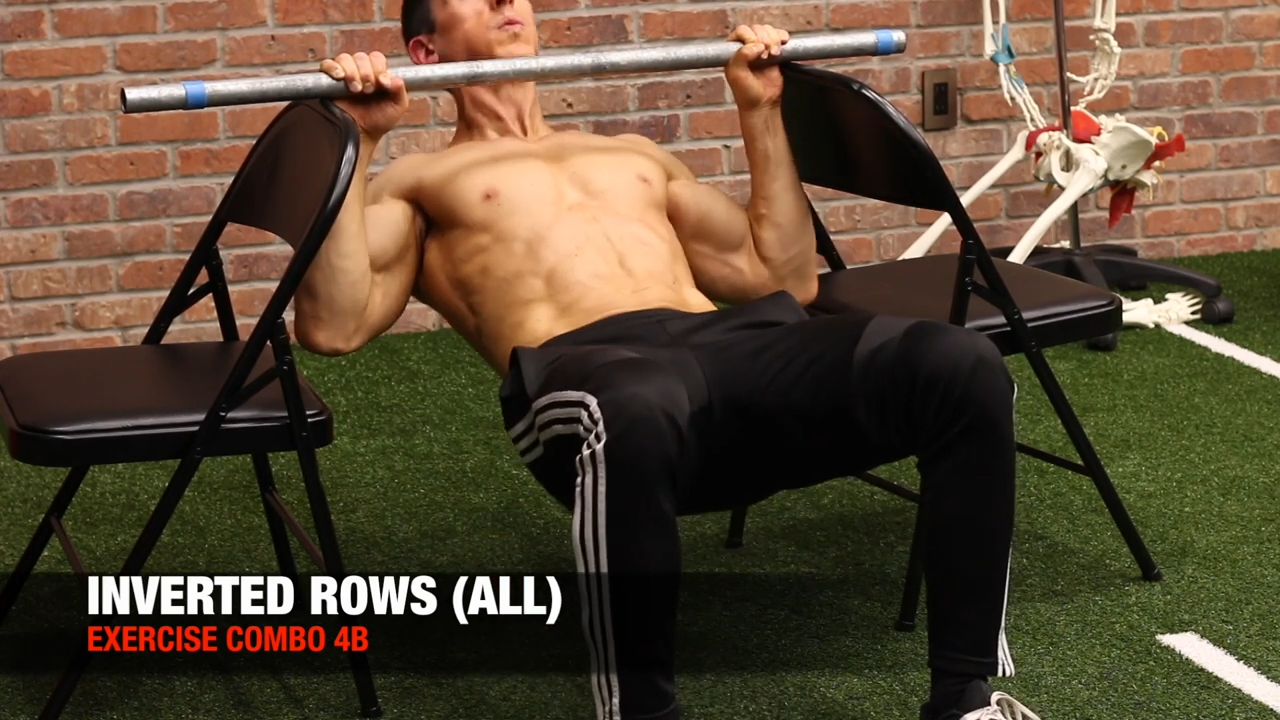
Exercise notes: This exercise helps us get more of a horizontal pull as opposed to a vertical one.
BACK WIDOW (ALL LEVELS)


Exercise notes: Every single muscle in the upper back and rear delt are engaged in this simple looking exercise.
CORE CIRCUIT
Ready to start with your lower abs and then move all around the core muscles?
Just as before, this is an “ab-focused” workout. This is targeting all of the core musculature.
AB HALO (ALL LEVELS)


Exercise notes: Lift the pelvis off the ground, engage the lower abs and try to create a half circle for a little bit of rotation.
V-UP TUCK (ALL LEVELS)

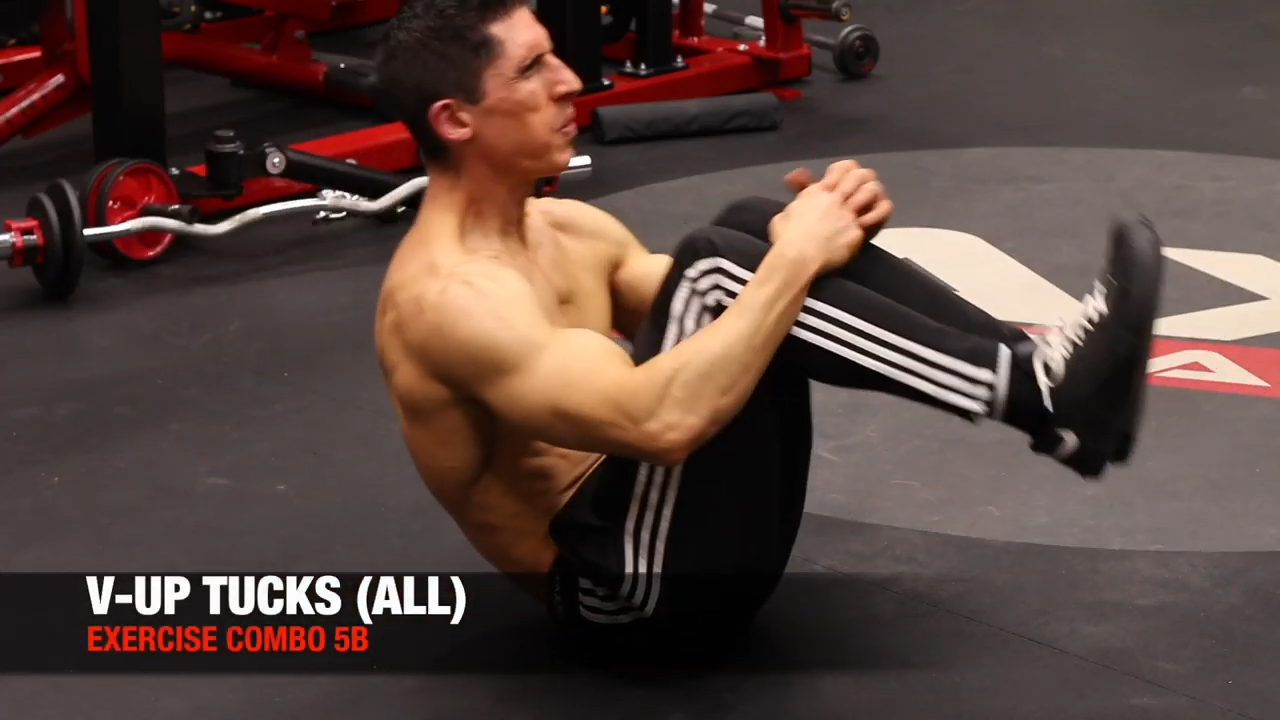
Exercise notes: Contract both the upper and lower abs by moving the upper and lower torso together throughout the entire movement.
SIT UP ELBOW THRUST (ALL LEVELS)

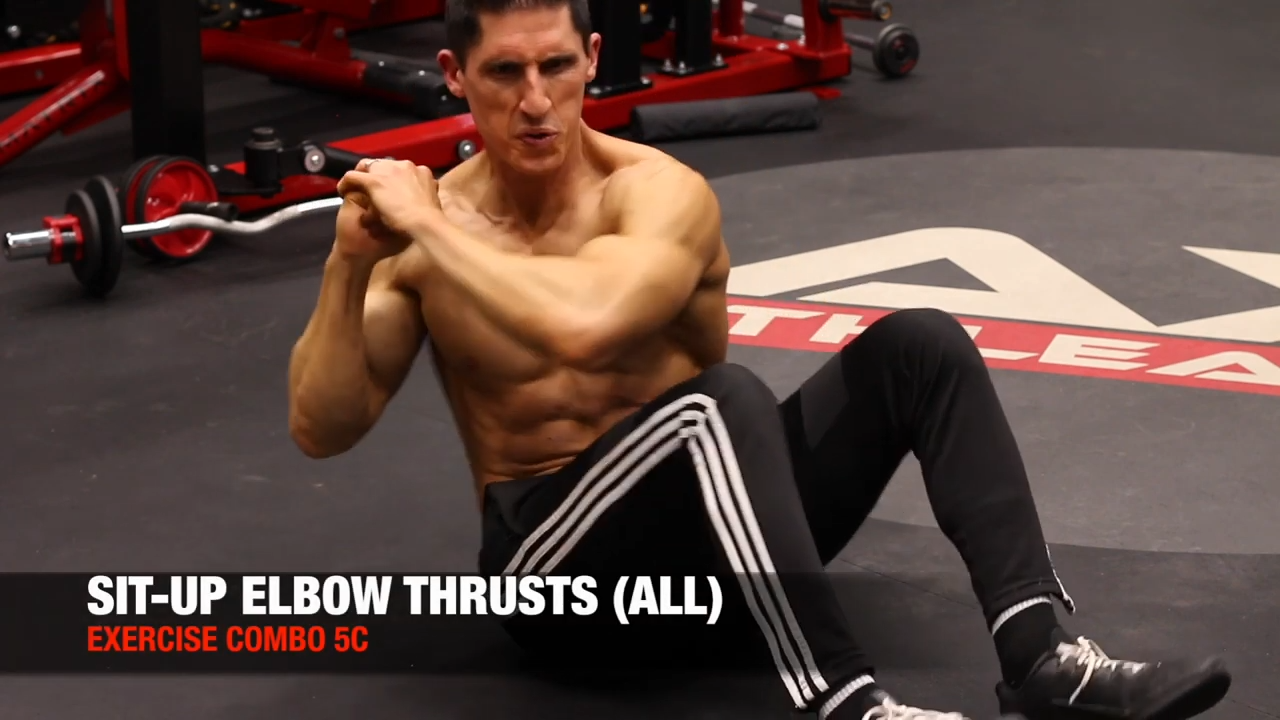
Exercise notes: This is primarily a top-down driven exercise with a little bit of extra oblique work.
CORRECTIVE
Ready to bring this home? Your final exercise in Workout B is a corrective one. It’s also one of my personal favorites.
This one movement incorporates your lower back and glutes, which are two muscle groups that do their best when working together.
REVERSE HYPEREXTENSION (ALL LEVELS)


Exercise notes: Lay face down over any stable surface and drive the lifting of the leg by first contracting the glutes and then allowing the low back to take over from there.
There you have it, guys. Your complete guide to calisthenics exercises and two full-body workouts to keep you busy for months.
As you could see from the workouts, it couldn’t be easier to incorporate some or all of these calisthenic exercises into your current workout program.
If you’re looking for a hybrid program, a mix up of weight-based training exercises and awesome body weight exercises, we can help! Check out our ATHLEAN-X programs to see which is the best fit for your goals and fitness level.

- Calisthenics is a form of exercise that only uses your bodyweight as resistance. With calisthenic exercises, instead of having to get up and add weight or change equipment like you do with weight-based training, all you have to is adjust your angle.
- The benefits of calisthenics exercises include improved flexibility, cardiovascular health, and coordination. They are low impact, time-efficient, and cost-effective, making them a great choice for people at all fitness levels who want to get stronger and build muscle without using weights or gym equipment.
- If you’re looking for an optimally designed calisthenics workout, you want to make sure that it follows this movement pattern format: Lower Body Anterior Chain, Upper Body Upper Push, Lower Body Posterior Chain, Upper Body Pull, Abdominal Circuit, and Corrective.
- Calisthenics, done with proper form and execution, is an excellent method for gaining muscle and strength. Essential to this process are choosing the appropriate exercises for your particular goals; learning the form of these movements so that they result in increased muscle mass; and being consistent with your exercise routines.
- Most importantly, calisthenics exercises can be incorporated into any type of workout calendar. No matter if you’re doing bodyweight exercises or weight-based resistance exercises, calisthenics can complement what you’re doing now.
CALISTHENICS WORKOUTS FAQS
Calisthenics refers to a form of exercise that uses purely bodyweight as resistance. A calisthenics workout consists of a series of bodyweight exercises that are performed in sequence. These exercises can be customized to suit your fitness level and individual goals, such as building muscle or increasing strength.
Yes, you can build muscle with just calisthenics. You don’t need weights to get strong and build muscle. Calisthenic workouts are just as efficient at building muscle and strength. However, instead of increasing the weight of your weights, you will have to challenge yourself by changing up the angle, stability or number of arms or legs you’re using.
A 20-minute calisthenics workout is enough to build muscle and strength. The calisthenic workouts recommended here should take around 20 minutes if you perform all 3 rounds.
The 5 types of calisthenics are:
- Lower Body Anterior Chain
- Upper Body Upper Push
- Lower Body Posterior Chain
- Upper Body Pull
- Abdominal Circuit
It’s not recommended to do calisthenics everyday. Just like with any other form of strength training that you do to build muscle, your muscles need rest in order to grow. In particular if your calisthenic workouts are total body, it’s better to take a day off in between workouts and do calisthenic workouts 3-4 days per week.
Calisthenics can be better than the gym because of their convenience and flexibility and time efficiency. In addition, if you are recovering from an injury or suffer from joint pain, calisthenics workouts are a low impact and gentle on the joints.
The best calisthenics workout programs are full body workout programs that hit the 6 major functions of calisthenics: lower body anterior chain, upper body upper push, lower body posterior chain, upper body pull, abdominal circuit and corrective exercise.
The benefits of calisthenics include building total body strength, being low impact, helping with improved coordination and enhanced mobility. Calisthenic workouts are also time efficient, convenient and flexible.

Jeff Cavaliere M.S.P.T, CSCS
Jeff Cavaliere is a Physical Therapist, Strength Coach and creator of the ATHLEAN-X Training Programs and ATHLEAN-Rx Supplements. He has a Masters in Physical Therapy (MSPT) and has worked as Head Physical Therapist for the New York Mets, as well as training many elite professional athletes in Major League Baseball, NFL, MMA and professional wrestling. His programs produce “next level” achievements in muscle size, strength and performance for professional athletes and anyone looking to build a muscular athletic physique.

















